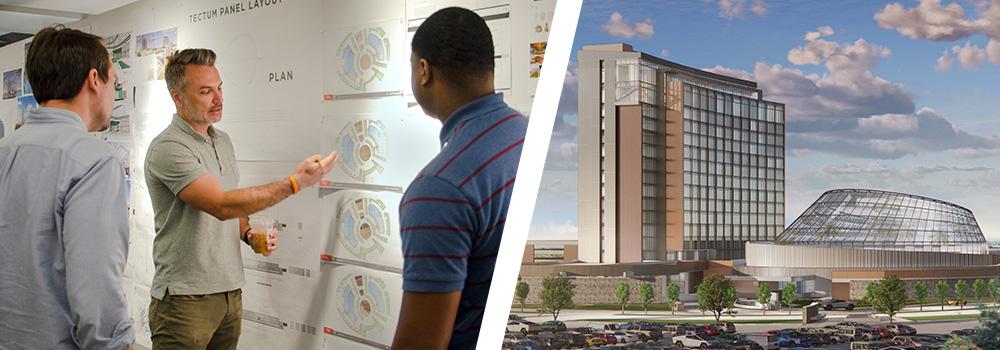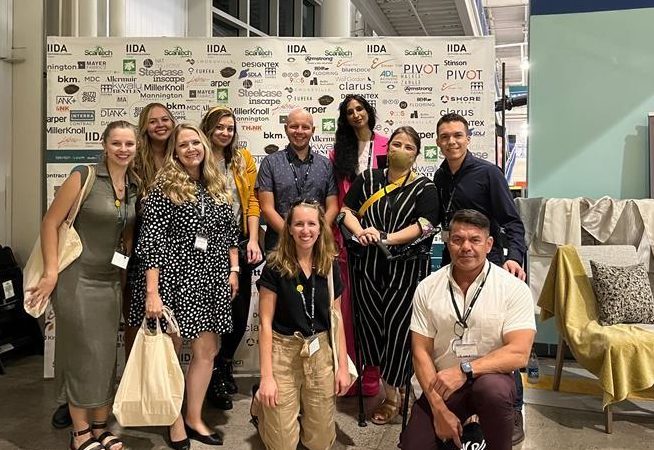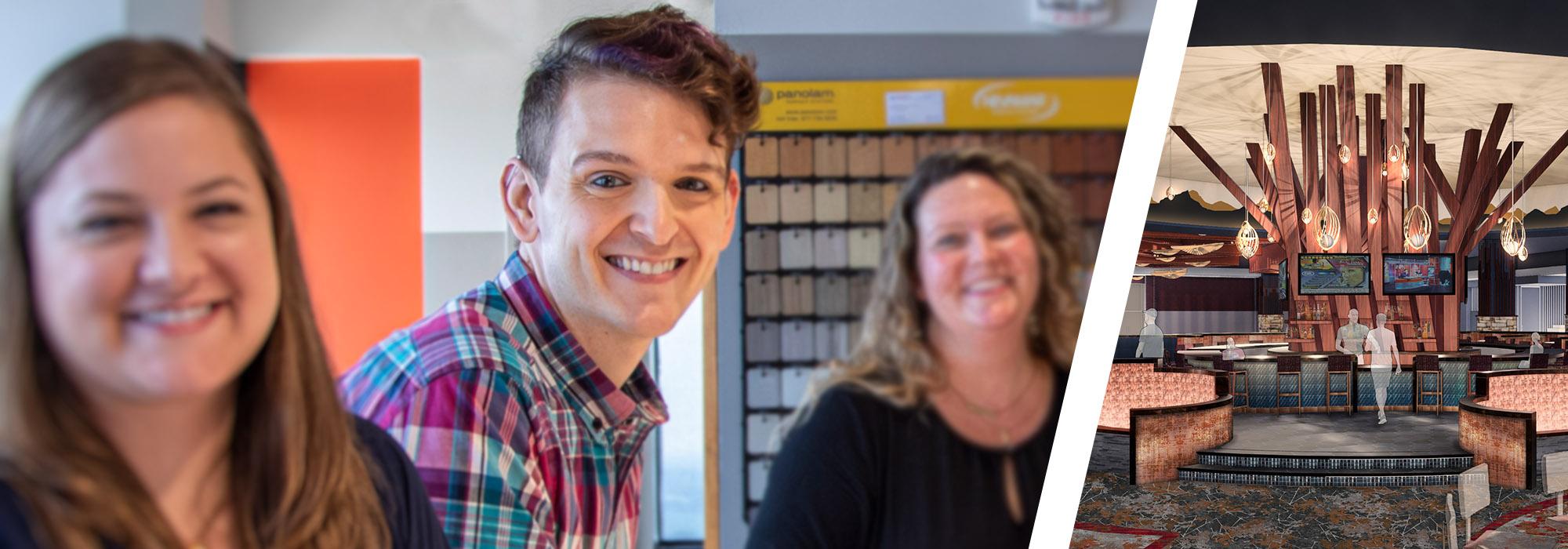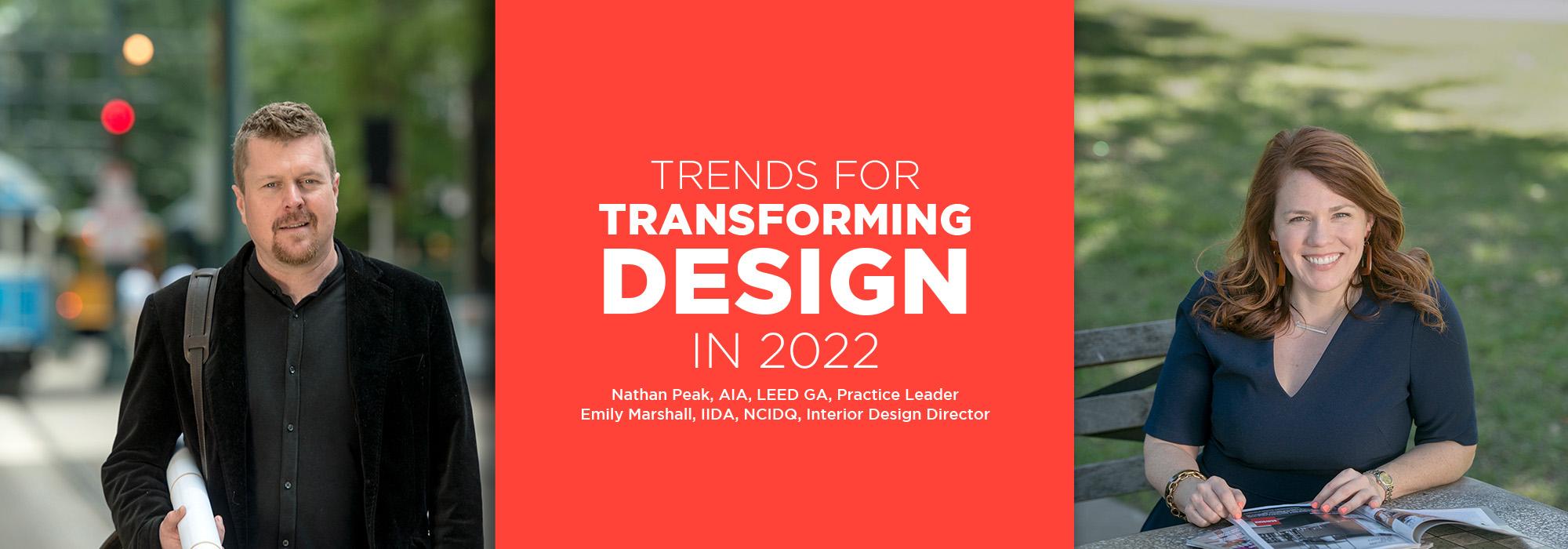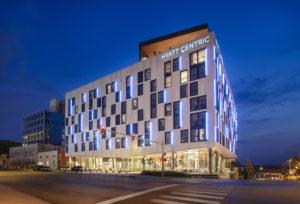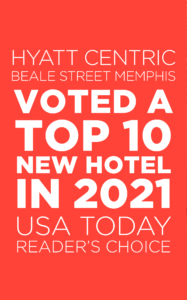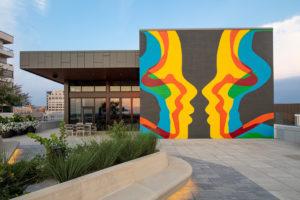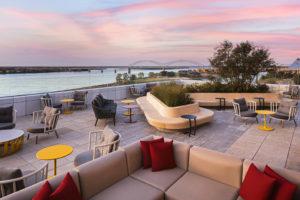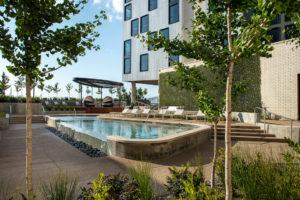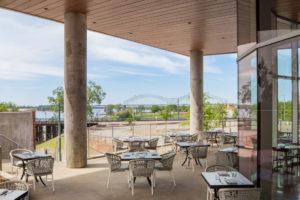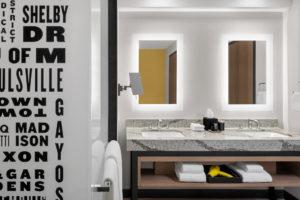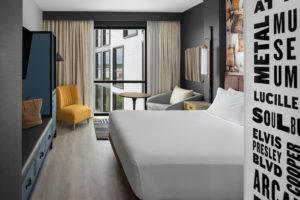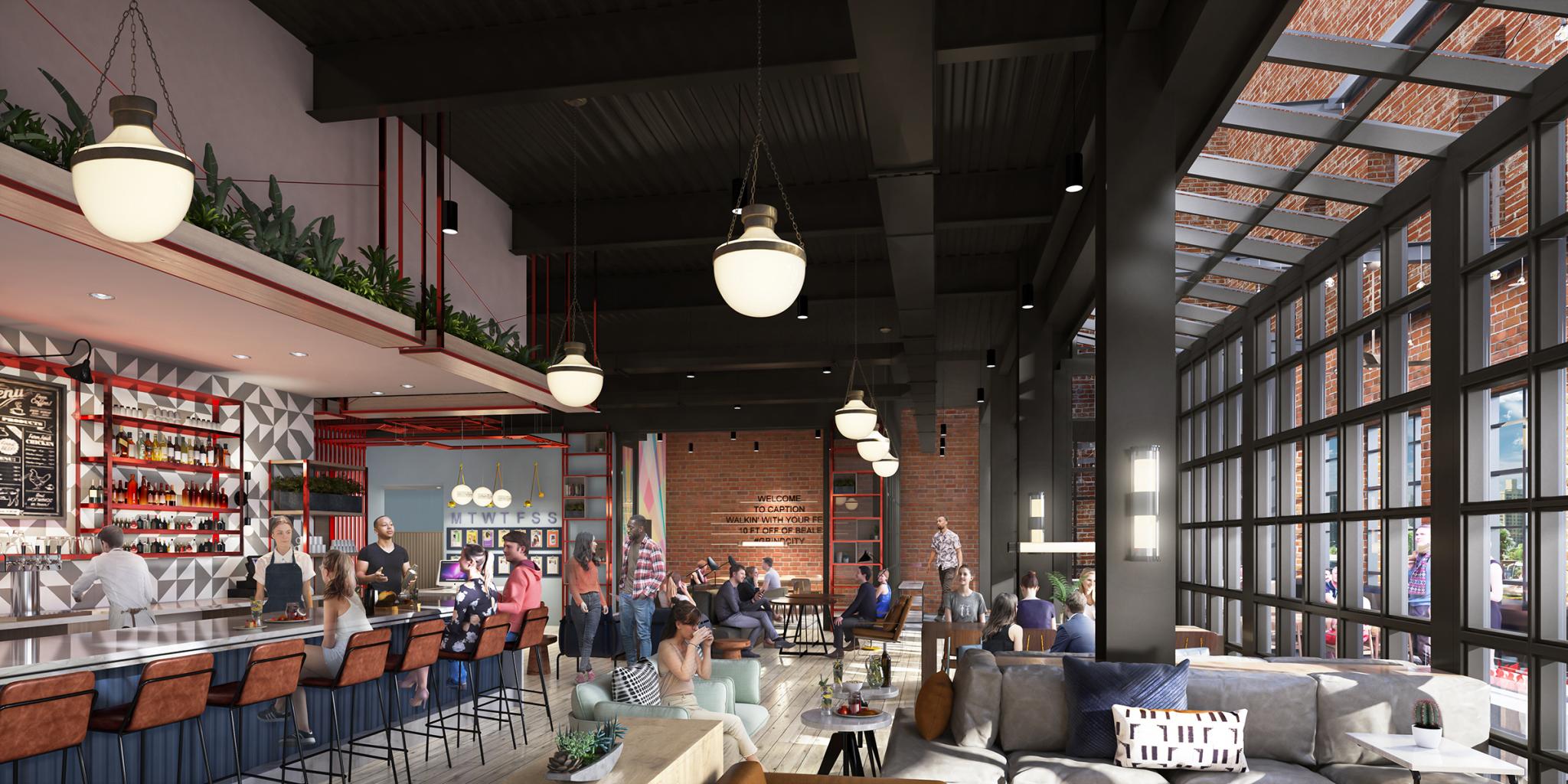HBG is Setting a New Design Documentation Standard
Our teams are enhancing design documentation accuracy through streamlined BIM workflows.
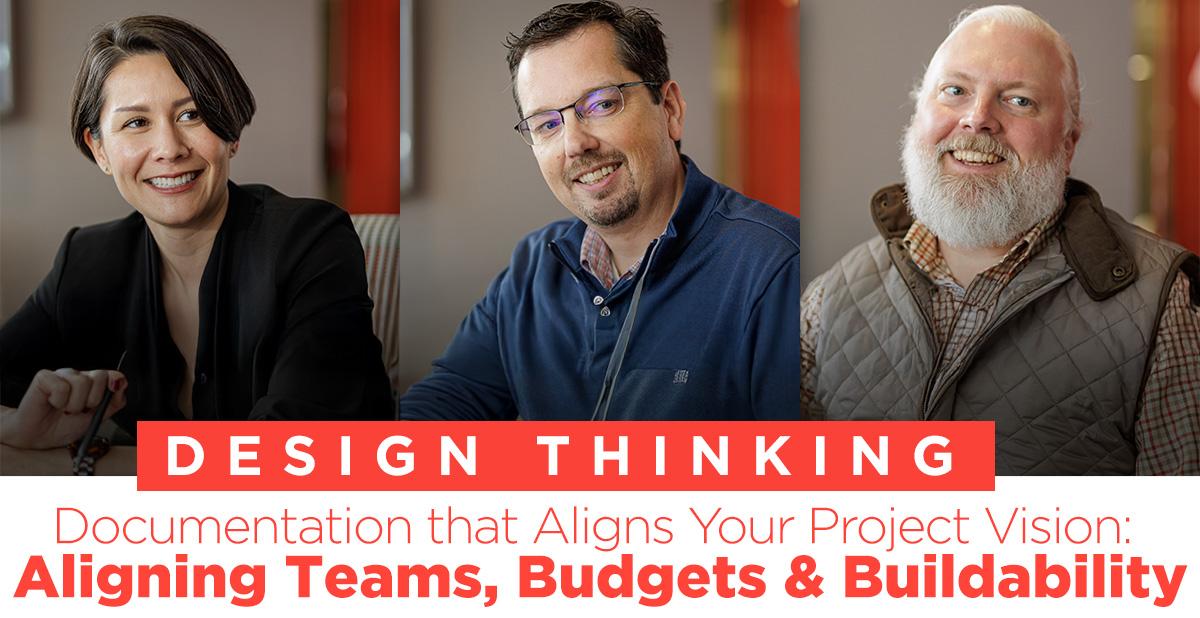 At HBG Design, we understand that exceptional architecture depends not only on great ideas. It also depends on how well those ideas are communicated through our documents. Design documentation is the critical bridge between concept and construction—and we’ve made that bridge stronger, smarter, and more reliable.
At HBG Design, we understand that exceptional architecture depends not only on great ideas. It also depends on how well those ideas are communicated through our documents. Design documentation is the critical bridge between concept and construction—and we’ve made that bridge stronger, smarter, and more reliable.
BIM Leadership Team
That’s why we’ve invested heavily in streamlining our BIM workflows, optimizing our Revit standards, and developing a more collaborative, integrated approach to design documentation. Processes are strategically led by a specialized BIM team - Documentation & Specification Leader/Senior Associate, Chris Devine, AIA; BIM Manager/Associate Chase Percer; and Practice Leader/Senior Associate, Leslie Thompson. These enhancements are helping us produce more accurate, coordinated, and efficient design documents—while reducing risk, change orders, and schedule impacts during construction.
Organized BIM Workflow Strategies
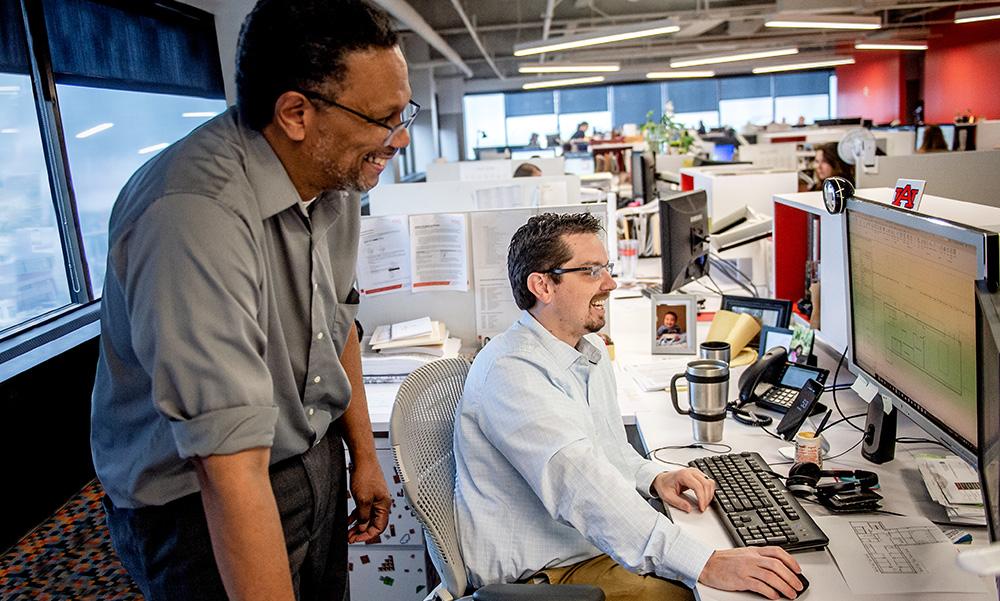 Our team uses a cloud-based approach built on Revit and Autodesk Construction Cloud (ACC) to enhance collaboration, secure data access, and bring consistency to every project.
Our team uses a cloud-based approach built on Revit and Autodesk Construction Cloud (ACC) to enhance collaboration, secure data access, and bring consistency to every project.
- Real-time Synchronization: Design and consultant teams work in a synchronized Revit environment, where program data and model information align throughout the entire process.
- Custom Revit Templates: We’ve embedded our QA standards and enhanced workflows directly into our Revit templates, giving every project a consistent starting point and a framework for success.
- Smart Content Management: Our library of parametric Revit 2D and 3D families and standard detail views helps eliminate redundant modeling.
- Automation & Model Health: Add-ons and internal tools help us automate repetitive tasks, maintain model integrity, and support staff training—all inside the project environment.
By standardizing and simplifying BIM processes, we’re helping project teams focus more energy on design thinking, problem-solving, and coordination—where their time is most valuable.
Consultant Integration from the Start
HBG Design's documentation process includes full coordination with our consultant teams from the outset. Standardized workflows and technology platforms support real-time collaboration and allow all partners to stay in sync as the project progresses.
A Culture of Quality, Not Just a Checkpoint
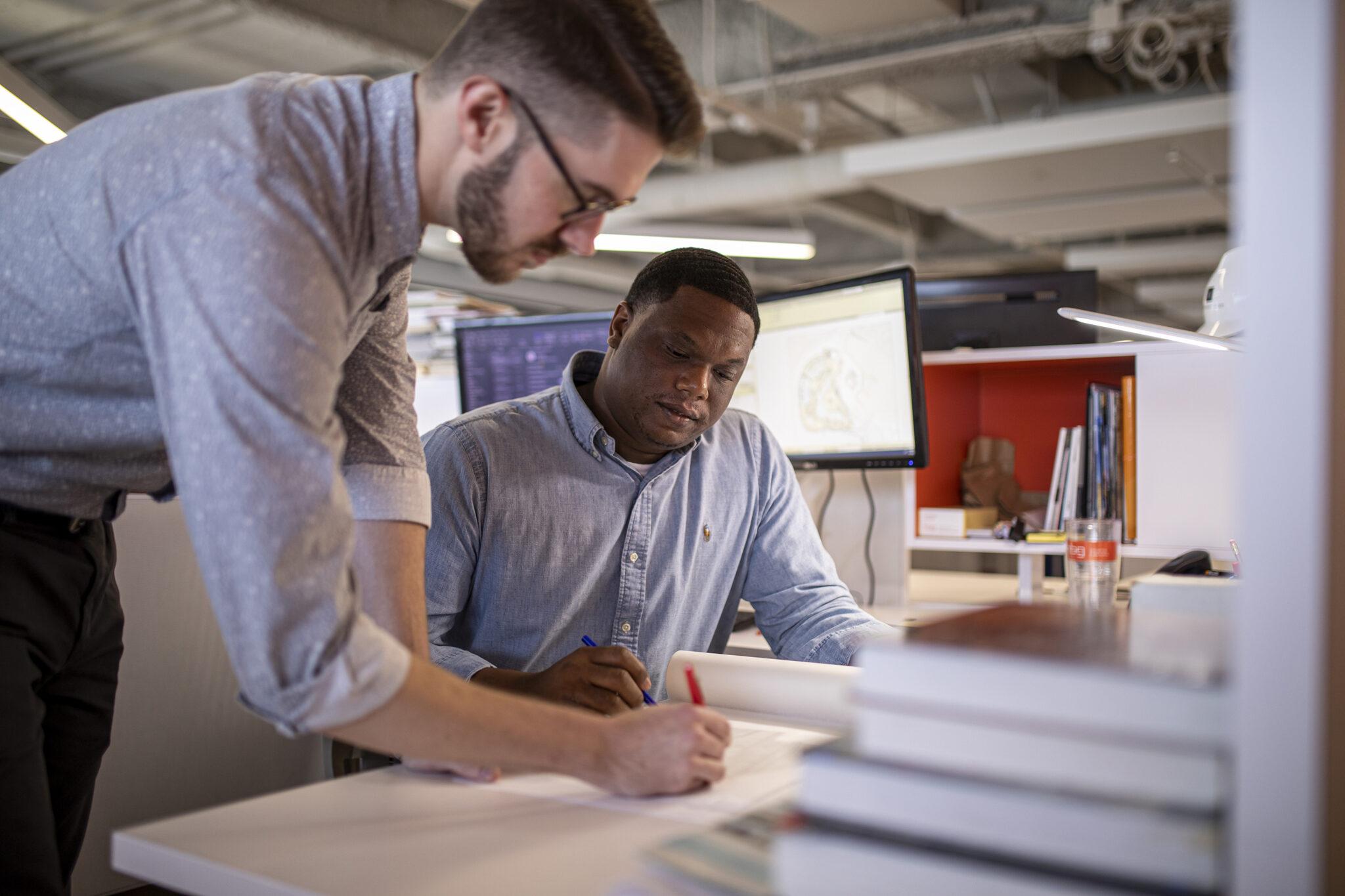 Our quality assurance (QA) and quality control (QC) systems are integral to our workflow. These aren't just isolated review phases—they’re embedded into how our teams think and work across every project phase.
Our quality assurance (QA) and quality control (QC) systems are integral to our workflow. These aren't just isolated review phases—they’re embedded into how our teams think and work across every project phase.
- QA starts early: With clear expectations for design documentation completeness, constructability, and coordination. Everyone on the team takes ownership of quality.
- QC adds a second perspective: Senior architects, interior designers, and reviewers outside the core team review drawings at key milestones for accuracy and alignment with HBG standards.
- Collaborative review in Bluebeam Studio: Allows teams to markup and resolve document comments in real time from anywhere.
For our clients, this means more accurate bids and schedules and a final product that faithfully reflects the design vision.
We’re constantly evolving our documentation systems to better support our clients, the contractor, our consultants. This contributes to the success of every project we touch.
At HBG Design, we believe that great documentation is great design. It's the difference between an idea that looks good on paper and a space that works beautifully in the real world.
Wellness Design in Hospitality
“Wellness isn’t a luxury anymore—it’s a baseline expectation,” says Landon Shockey, ASID, NCIDQ, Senior Interior Designer at HBG Design. “The most successful environments are both sensory-rich and versatile—crafted to evolve with guest needs while creating meaningful, wellness-infused experiences.”
In today’s hospitality industry, wellness design is no longer an amenity—it’s a strategic must. From spa suites to biophilic architecture, hotel and resort guests expect spaces that support how they want to feel, move, and recharge.
What Is Wellness Design in Hotels and Resorts?
Wellness design integrates mental, physical, and emotional wellbeing into the built environment. It’s not one-size-fits-all. Sometimes wellness means:
-
A calming in-room palette and soft glow lighting
-
Aromatherapy showers for personal retreat
-
Full-service spas and fitness spaces
-
Climate-controlled pool environments
-
Outdoor-inspired architecture that promotes natural connection
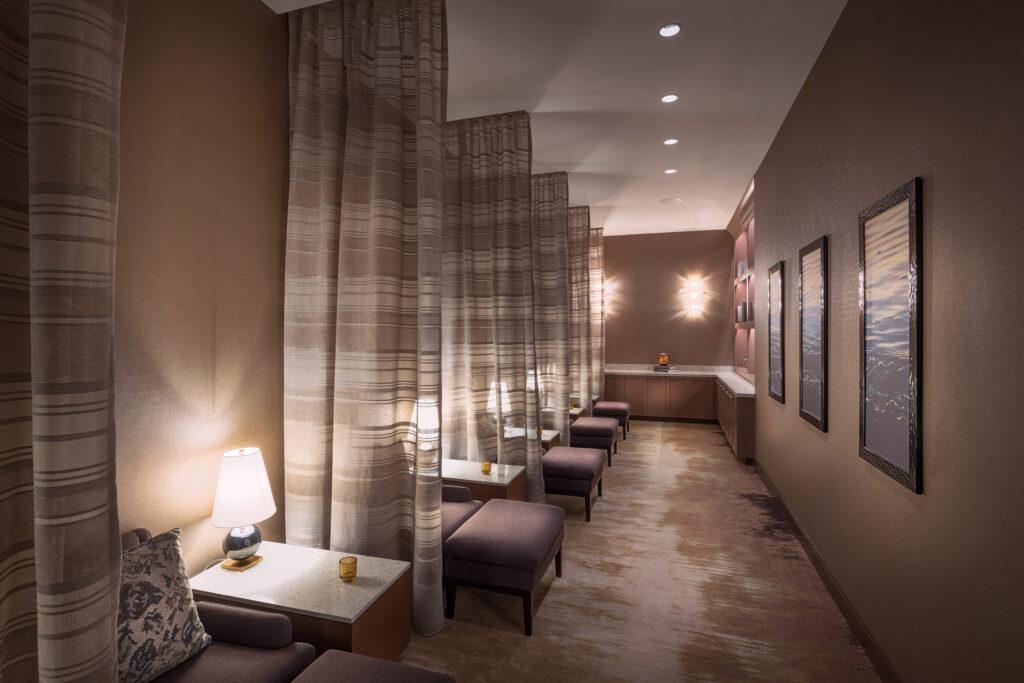
At HBG Design, we scale wellness design to match how different guests want to engage—whether that’s stillness, movement, or immersive experience.
WinStar Resort Spa – Thackerville, OK
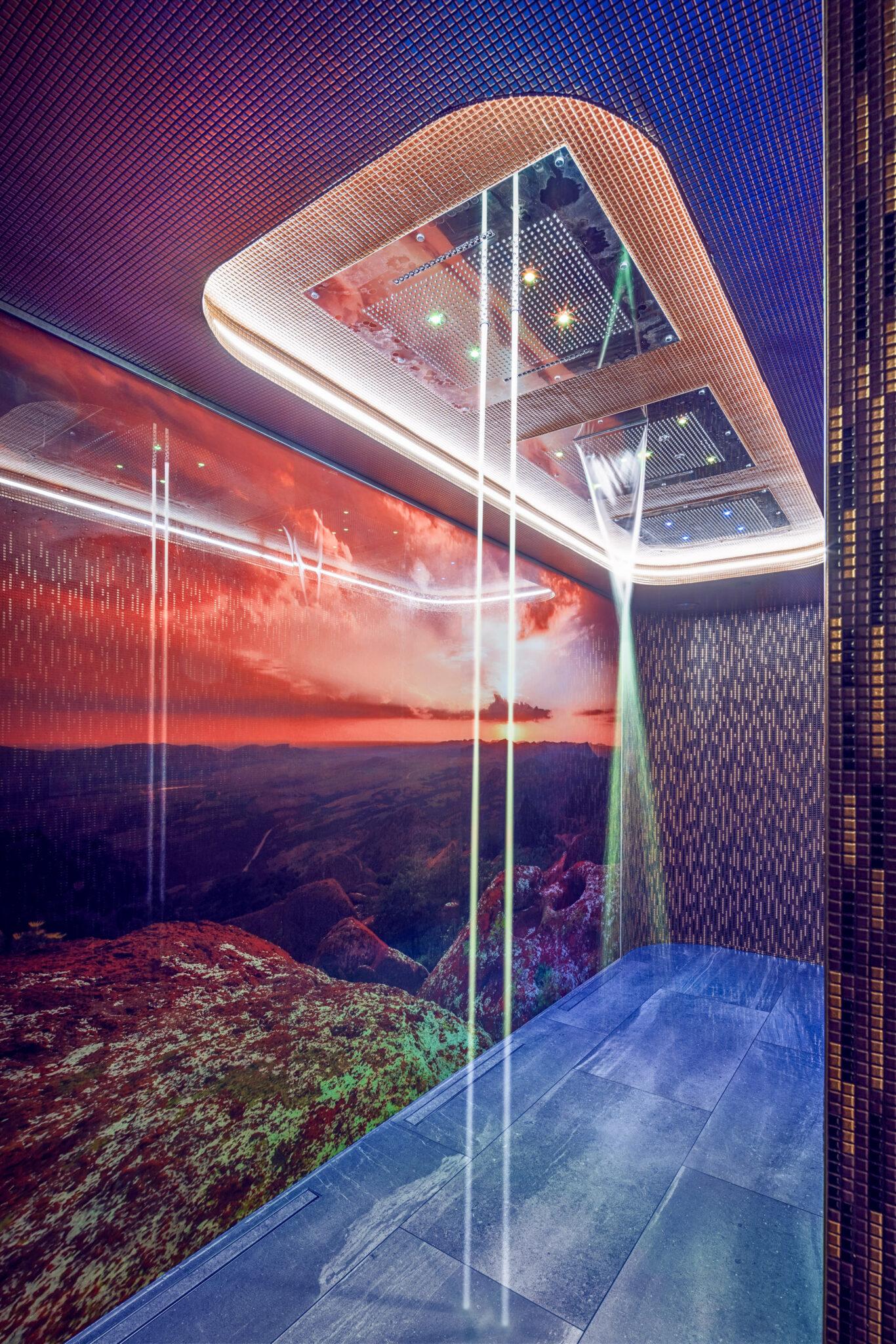
Guests from busy metro areas like Dallas/Ft. Worth and Oklahoma City arrive seeking peace. This spa retreat offers:
-
Touchless therapies
-
Aquathermal bathing
-
Ambient experience shower
Each sensory element is designed to encourage guests to slow down and reconnect.
Cascades at WinStar – Thackerville, OK
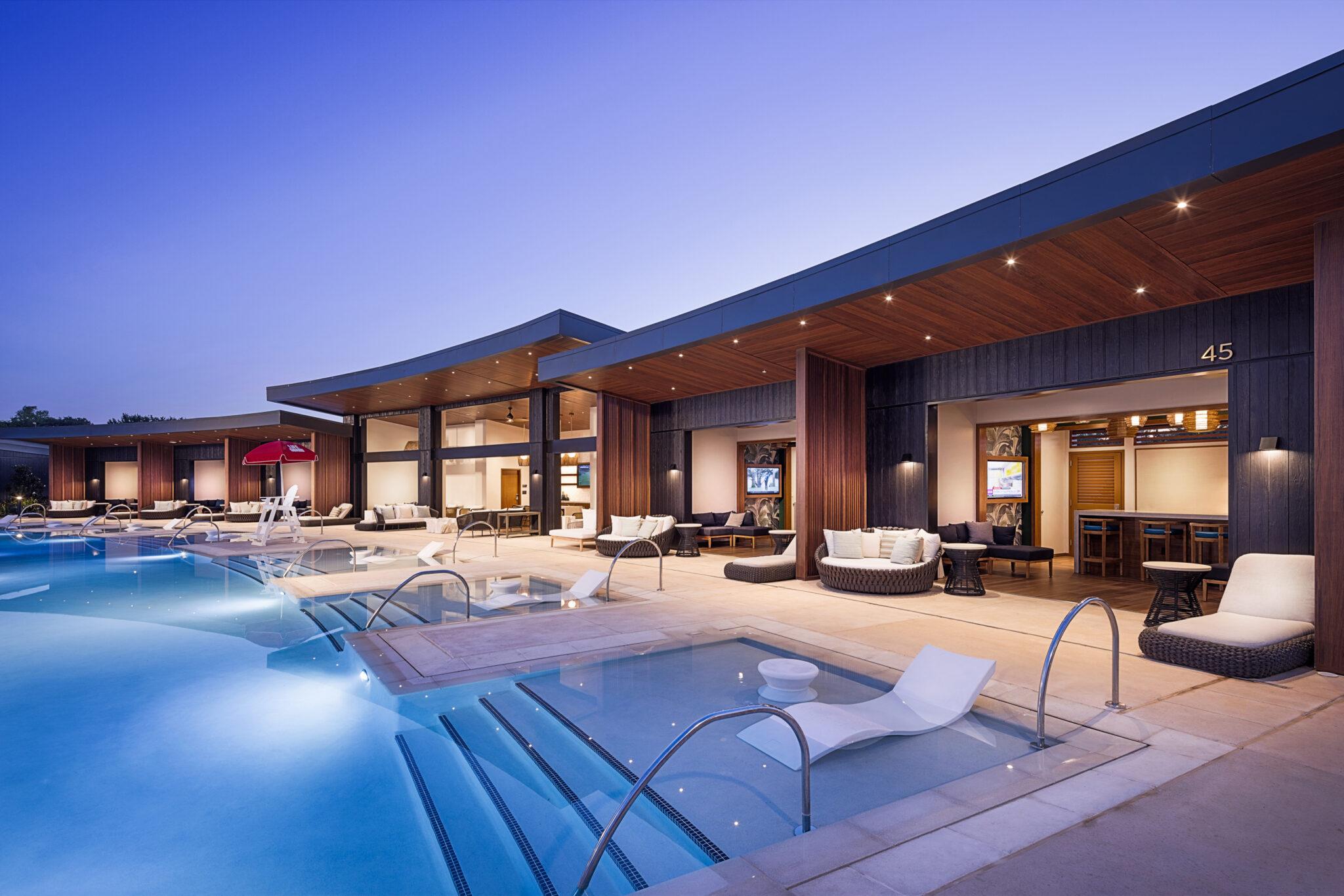
You don’t need an ocean to feel serenity. At Cascades, wellness design comes to life through:
-
Lounge pools shaped by ocean-inspired forms
-
Curved daybeds for socializing or solo relaxation
-
Fluid zones that feel like a water-based escape in the heart of the Midwest
Astral Spa at Oaklawn Resort – Hot Springs, AR
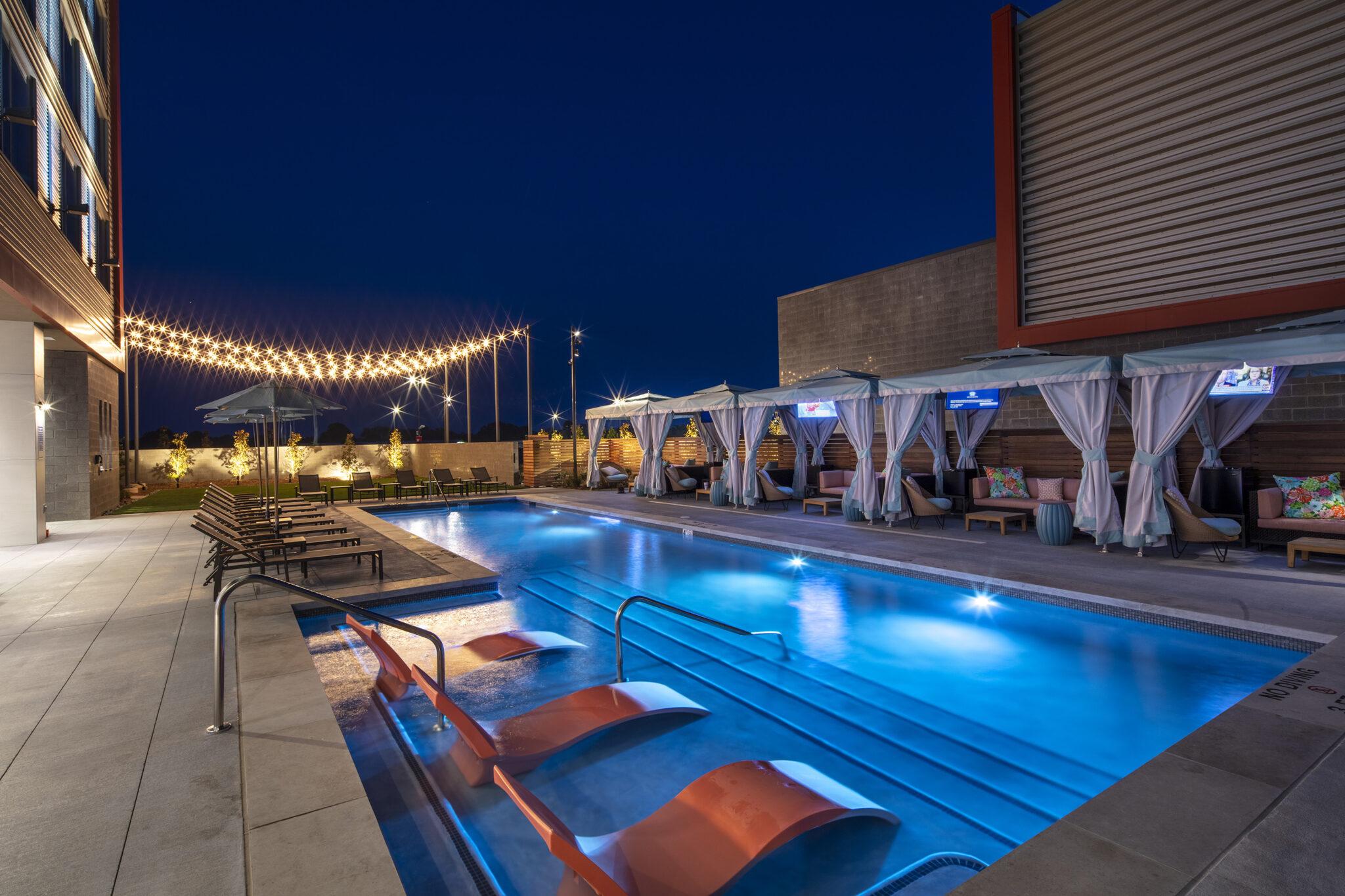
Wellness also means movement. This spa integrates:
-
Fitness center and outdoor pool with in-water loungers
-
Yoga lawn and shaded treatment areas
-
Multiple ways to stretch, breathe, and rejuvenate
Wawyé Oasis at Gun Lake Resort – Wayland, MI
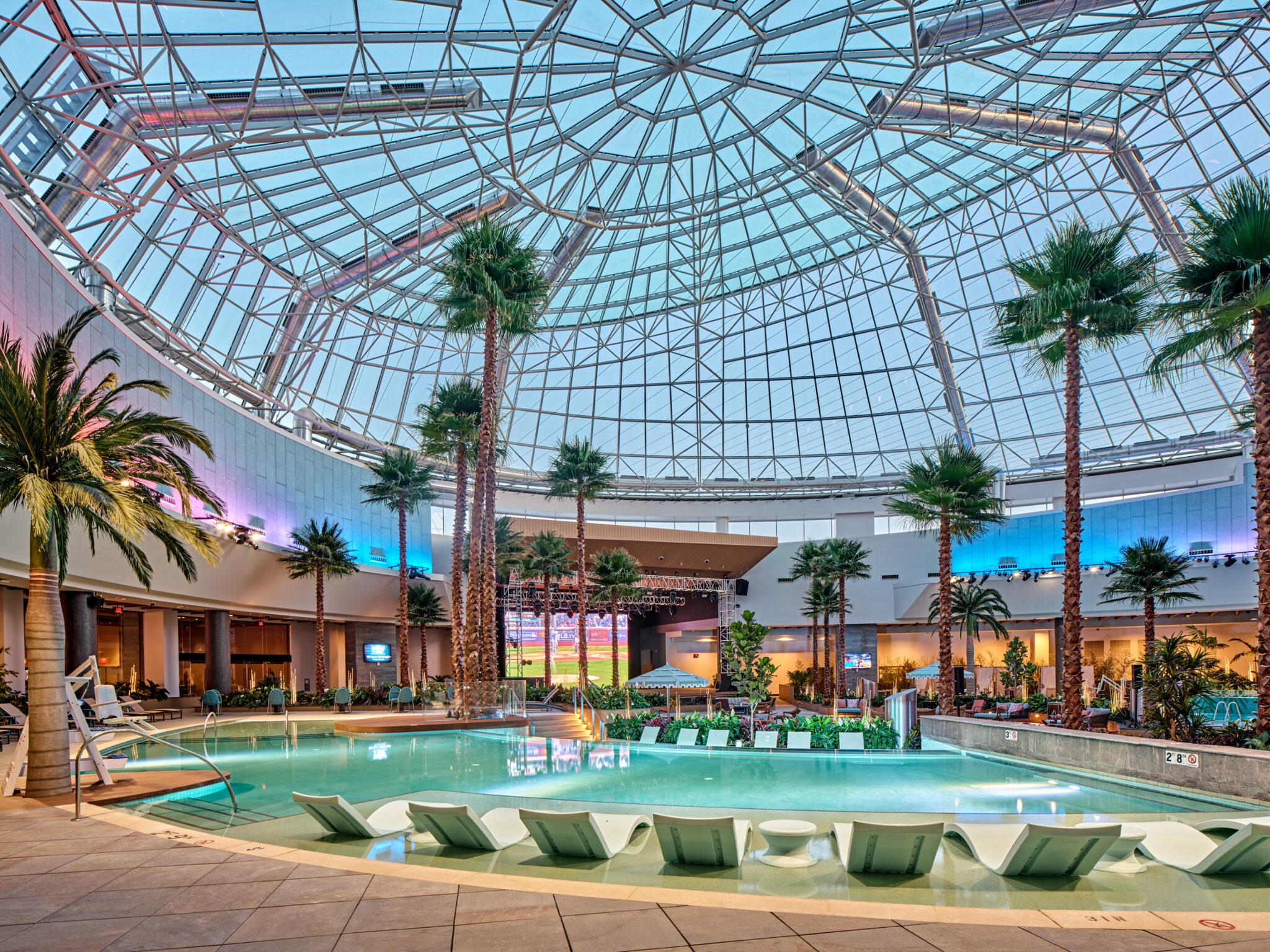
In Michigan’s cold climate, warmth and light are vital to wellness. This indoor tropical atrium offers:
-
Six-story, climate-controlled space
-
Poolside lounging by day
-
High-energy concerts and social events by night
This is wellness design that flexes to fit guest energy throughout the day.
Cache Creek Resort - Biophilic Wellness Design in Action
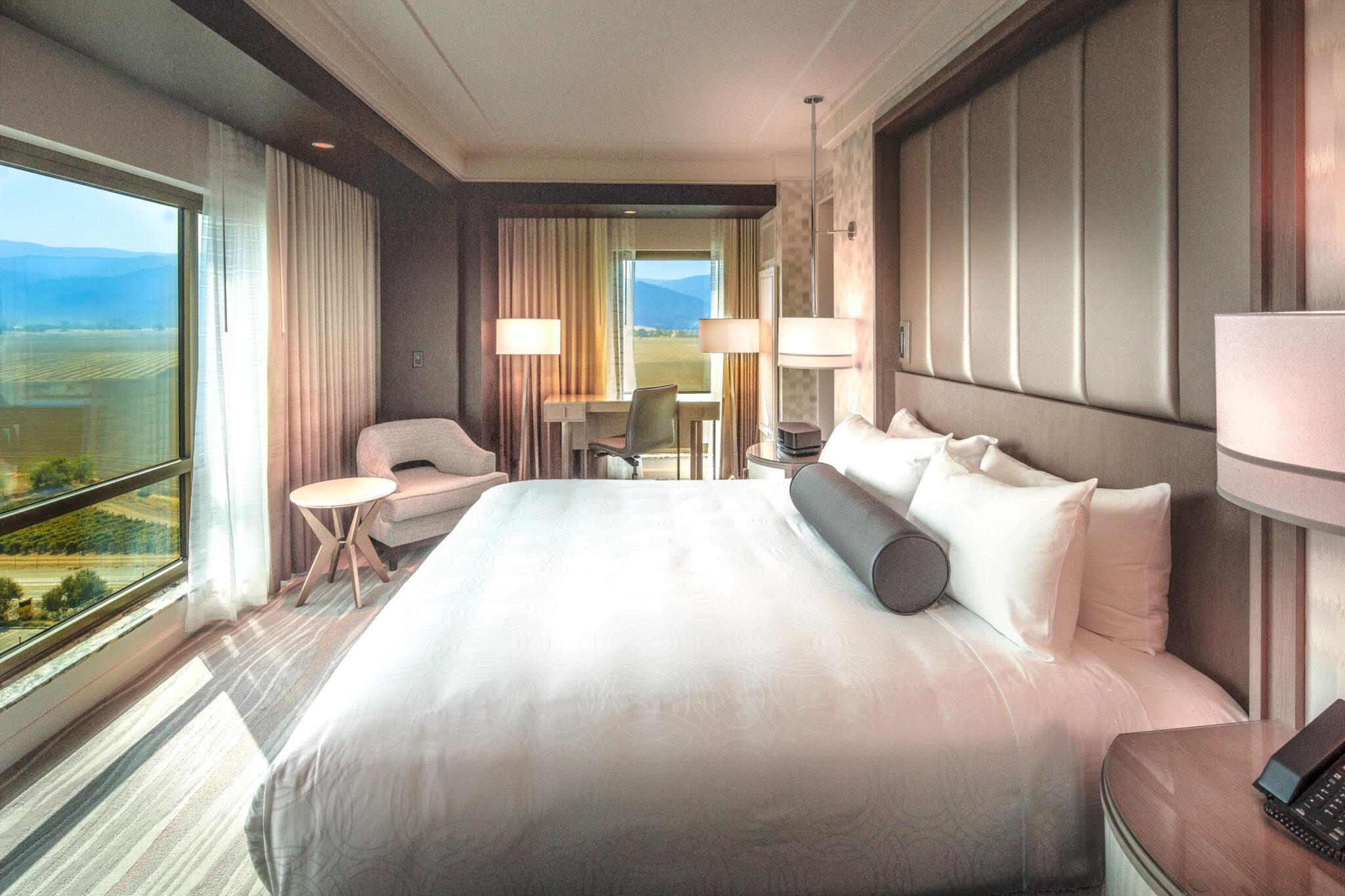
At Cache Creek Resort (CA) nature plays a leading role. We use:
-
Natural light and panoramic views
-
Organic textures and materials
-
Outdoor-inspired interiors to foster a grounded, calming atmosphere
The Future of Hospitality Is Wellness-Focused
Designing for wellness is no longer optional. It’s a powerful differentiator—and a way to build lasting emotional connection between guests and place. By focusing on wellness design, hospitality brands can meet guests where they are and give them the freedom to relax, move, and reconnect—on their own terms.
Thankful for Global Design Explorations: Nathan Blair's Colombian Adventures
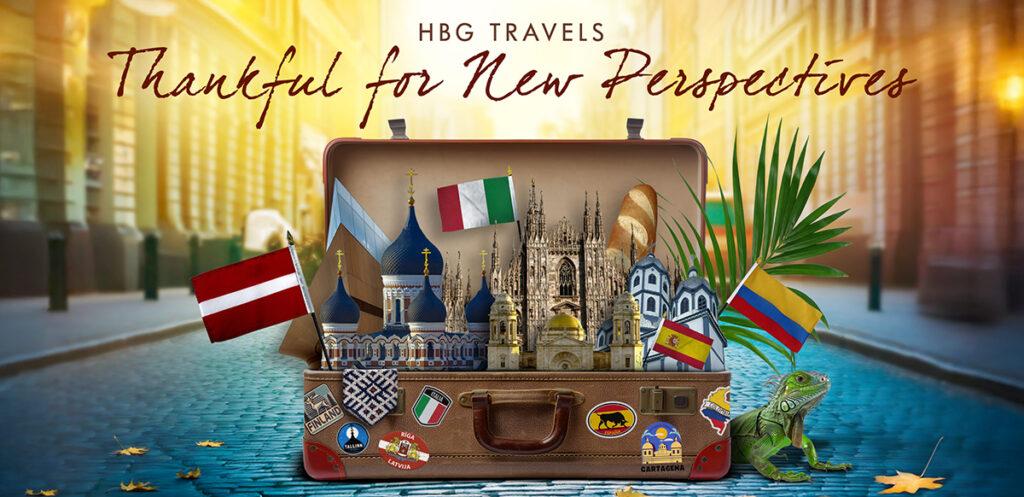
In the world of architecture and interior design, travel offers invaluable insights, influencing how we approach materials, space, color, how we translate culture into the built environment, it even informs our own place in the world. In addition to the adventures by our numerous GOH Travel Scholarship winners, other HBG Design team members regularly embark on distinct journeys of their own. Traveling through regions such as Eastern Europe, Western Europe and South America, they encounter rich tapestries of contrasts and vibrant influences that provide fresh perspectives on life, inspiration, and creativity. HBG's global design explorations directly inform and help shape our project designs.

This holiday season, as HBG Design waits patiently for the announcement of our 2025 GOH Travel Scholarship recipient, we invite you to follow along as we share personal and professional insights from HBG Principal Architectural Designer, Rob Jurbergs, AIA; HBG Lead Architectural Designer, Nathan Blair, AIA; and Lead Interior Designer, Christine Wass, IIDA, NCIDQ, through their own international explorations!
HBG's Global Design Explorations:
Lead Architectural Designer, Nathan Blair's Insights from a Journey Through Colombia
This year, I was fortunate to explore a few places, but Colombia stood out as the most unique by far. One of my close friends got married there over Memorial Day weekend, so we thought, why not turn it into an adventure? We decided to spend the week before the wedding touring around the country, diving into its vibrant culture and history, and discovering firsthand what makes Colombia special.
Bogota: A City of Layers and Influence

The trip began in Bogota, Colombia's bustling capital, a sprawling metropolis with the energy and challenges of a fast-growing urban center. It was a bit of a culture shock at first, so to ease into the local culture we hired a guide to help navigate Bogota’s streets and nuances, giving us great insight into the country. As a gateway between North and South America, Colombia has influences from both continents, though the Spanish impact is more visible. Bogota’s architecture and culture vividly reflect its Spanish colonial roots intertwined with influences from ancient indigenous cultures, including Incan elements. We saw this blend in everything from architecture to food. Speaking of food, it was incredibly fresh, with a variety of fruits we rarely see in the U.S.
Bogotá is a city on the rise, but like many growing cities, it faces challenges. Traffic is intense, with inadequate public transport options, which makes commuting difficult for those who can't afford to live in the city center. There's also a water shortage despite the frequent rain, as the aquifer struggles to keep up with demand. Bogota's challenges with infrastructure and water scarcity spark considerations on sustainable urban design—how can we plan spaces that serve and sustain growing populations without straining natural resources?
Cartagena: Urban Design Adapted to the Climate

After Bogotá, we headed to Cartagena, a vibrant city along the Caribbean coast founded by the Spanish in the 1600s. This experience brought lessons in adapting architecture for modern uses and to the climate. We stayed in a former Spanish convent from the 1650s, beautifully repurposed in the 1950s as a hotel, and expanded in the 2000s, which itself demonstrates a commitment to adaptive reuse.
The heat was intense, but the architecture in Cartagena is designed to handle it. Many buildings have deep courtyards filled with trees for shade, and most daytime activity happens on the ground floor, with high ceilings to allow the heat to rise. At night, the upper-level rooms take advantage of the evening breeze—a simple yet effective way to beat the tropical heat. Cartagena is relatively quiet during the day, but as the sun sets, it transforms into a lively, vibrant city.

Pereira and Filandia: Nature and Culture Collide
The final leg took us to Pereira, the largest city in Colombia's coffee region, where the lush, high-elevation jungle teems with color and life. Flying into the area, we saw coffee plantations stretching for miles among the vivid green mountains. Outside the city, it’s practically a jungle. We discovered a vibrant, sensory world of exotic creatures and plants. The wedding took place at a boutique hotel in the jungle, where we encountered all sorts of wildlife—giant iguanas, snakes, birds, and insects.
Colombia’s flora and fauna influenced the local design aesthetics, which are lively and multihued, embodying its own unique sense of place through architecture and design. This was evident during a visit to Filandia, a tourist village perched high on a mountain with stunning views. Filandia caters mostly to Colombian tourists, unlike Cartagena, which is more international. The day after the wedding, we traveled there on a chiva bus, a colorful party bus where the celebration continued all the way to the village.
Colombia’s rich palette and eclectic design language starkly contrasts with the streamlined aesthetics common in the U.S. They embrace bold, vibrant choices without fear—a design approach that feels liberating. This experience served as a reminder to stay playful and open to layering elements in our projects.
Lessons Learned in Design and Culture: HBG's Global Design Perspectives
Colombia was an incredible experience, filled with culture, color, and warmth. I left feeling like I'd glimpsed something truly inimitable. This journey through Colombia was a personal trip, but I found examples everywhere in how design, climate, and culture interweave, each reflecting and responding to the other.
- Nature as a Palette: Colombia’s landscape, with its tropical climate and diverse ecosystems, showcases vibrant colors and textures. This inspired a fresh approach to using color in design, especially as a tool to connect indoor spaces with their surroundings.
- Adaptive Solutions for Climate: Cartagena’s architectural techniques to cope with heat—high ceilings, shaded courtyards, and spatial arrangement—are reminders of the power of low-tech solutions tailored to the environment.
- Embracing Design Experimentation: The lack of stringent design codes and lower costs allow Colombians to experiment freely. This approach creates dynamic, layered spaces. In the U.S., we often start with similar ideas, but costs and codes tend to streamline our designs. But Colombia’s spirit of design experimentation can inspire new thinking, within the codes, of course.
- Communicating Design Language: In Colombia, we found that basic Spanish and hand gestures went a long way in bridging the language gap, with Google Translate helping in a pinch. Staying in hotels made communication a bit easier, but the experience underscored an important reminder: in design, we often need to find new ways to clearly convey our ideas to clients or laypeople who may not speak the same "design language." Embracing different perspectives and adapting our communication approach is essential for creating understanding and connection.
As I reflect on my trip, here are a few more general takeaways for those planning a trip to Colombia:
- Colombia lacks extensive interstate or rail connections, so air travel is the quickest way to get around.
- Much of Colombia is at high elevations, which, combined with rain and the equator, makes for unique growing conditions.
- The food is fresh, diverse, and features many fruits that are rare in the U.S.
- The country is filled with vibrant birds and flowers, including more hummingbird species than anywhere else.
- Prices in Colombia are a stark contrast to what we're used to in San Diego. Where coffee costs $5+ at home, we enjoyed excellent coffee and a pastry for less than $2.
- Colombian coffee is delicious, and, thankfully, everywhere!
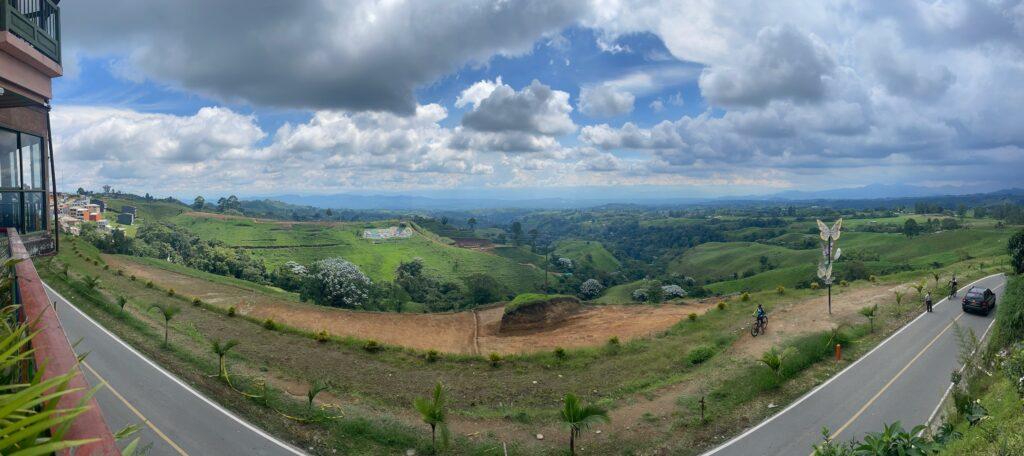
At HBG Design, we see travel as a powerful source of inspiration, broadening our perspectives and enriching our work. This month, we honor the impact of global exploration on our designs—a legacy rooted by our co-founder, Gregory O. Hnedak, FAIA, whose passion for experiential learning lives on in HBG’s GOH Travel Scholarship. Greg believed that immersing oneself in diverse cultures opens doors to deeper, more meaningful design. His challenge to us remains:

Thankful for Global Design Perspectives: Rob Jurbergs Explores His Baltic Heritage

In the world of architecture and interior design, travel offers invaluable insights, influencing how we approach materials, space, color, how we translate culture into the built environment, it even informs our own place in the world. In addition to the adventures by our numerous GOH Travel Scholarship winners, other HBG Design team members regularly embark on distinct journeys of their own. Traveling through regions such as Eastern Europe, Western Europe and South America, they encounter rich tapestries of contrasts and vibrant influences that provide fresh perspectives on life, inspiration, and creativity. HBG's global design perspectives directly inform and help shape our project designs.
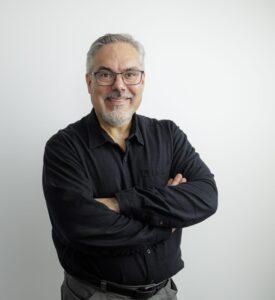
This holiday season, as HBG Design waits patiently for the announcement of our 2025 GOH Travel Scholarship recipient, we invite you to follow along as we share personal and professional insights from HBG Principal Architectural Designer, Rob Jurbergs, AIA; HBG Lead Architectural Designer, Nathan Blair, AIA; and Lead Interior Designer, Christine Wass, IIDA, NCIDQ, through their own international explorations!
HBG's Global Design Perspectives:
Principal Architectural Designer, Rob Jurbergs, Journeys Through Finland, Estonia, and Latvia
This past summer, I embarked on an incredible journey to Finland, Estonia, and Latvia. My last name, Jurbergs, originates in Latvia, a Baltic state tucked between the west side of Russia and Poland, and just south of Sweden. After World War II, a significant Latvian community settled in Senatobia, Mississippi, including my grandparents, aunt, and uncle. Growing up, I heard countless stories of Latvia’s rich traditions, especially the Midsummer celebration, the biggest holiday of the year. Latvians celebrate both the nights of Midsummer, Līgo, and the next day, which is known as St. John’s Day or Jāņi (Jani). This is a time when people gather, light bonfires, and celebrate the longest day of the year—much like how Americans celebrate the Fourth of July. This tradition has been on my bucket list for as long as I can remember, and this trip became my opportunity to experience it firsthand.
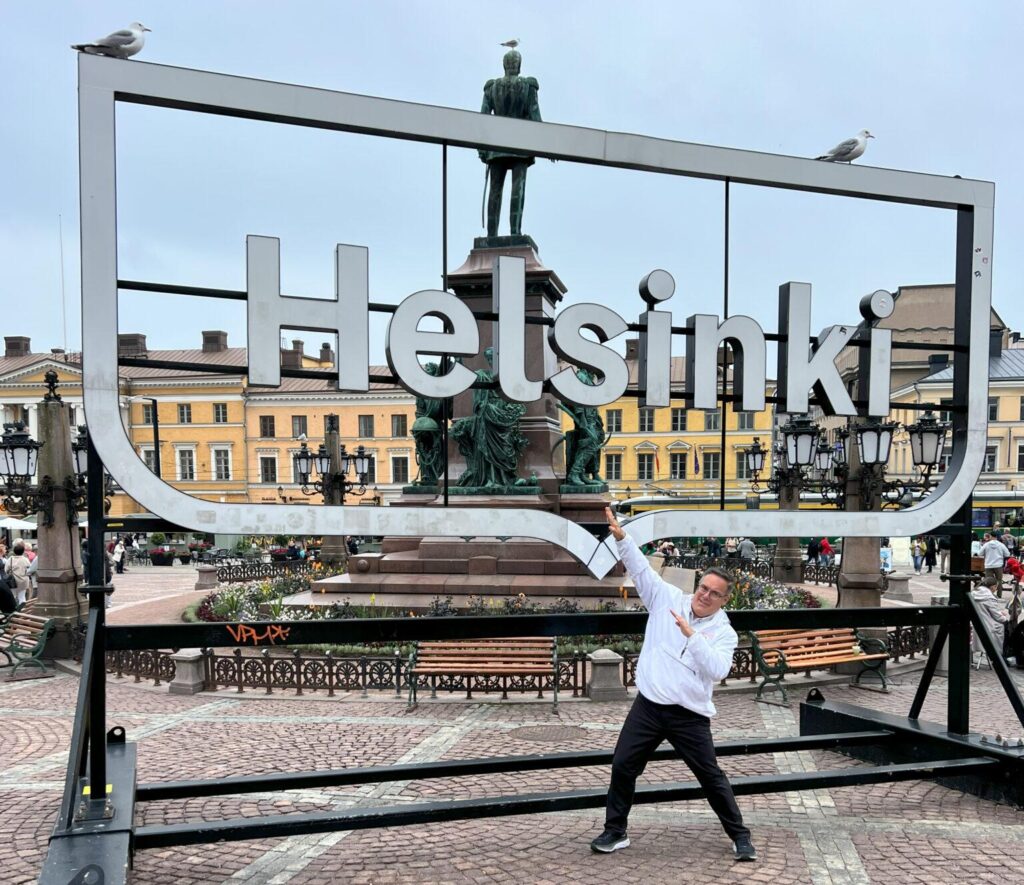
Flying into Helsinki, Finland, a friend and I stayed in the heart of downtown. I found myself surrounded by this modern city and striking architecture, with the only goal being to immerse myself in my surroundings of this centuries-old waterfront commerce hub that continues to thrive today. Helsinki’s architecture reflects its history, and intriguing Orthodox church architecture, with designs that hint at Russian influence.
Helsinki is now known as a design capital, and the city’s blend of modern innovation with rich arts immediately resonated with me. I visited the Kamppi Chapel, an iconic wooden structure resembling a large boat, and was captivated by its simplicity and peacefulness. Kamppi Chapel has been featured in numerous design publications; and it’s a powerful reminder of how architecture can create serene, introspective spaces in the middle of bustling cities.

I was excited to visit the Oodi Public Library, a significant piece of architecture that appears to float like a sail. The wood exterior rises vertically like an inverted ribbon and curves seamlessly into a canopy, with light flooding in to create a feeling like you’re at the prow of a ship. The building even ramps up at the end offering overlook areas—just a pure, immersive experience. This incredible space was filled with angular structure and expansiveness, with steps leading up to sit and take in the amazing light quality. The glass also had a special print that helps reduce heat and glare. It’s amazing how thoughtful design can elevate a public space such as a library, making it functional, communal, and inspiring.

A highlight of my Finnish travels was visiting the Loyly sauna, an experience I'll never forget the rest of my life. This waterfront spa merges the region’s traditional sauna culture with incredibly unique design. Built with a double skinned system of exterior wood slats and slides and sheer glass behind, the building allows glimpses of the sea from within while appearing impenetrable from the outside, like a rock from the harbor. This emphasized to me how nature and architecture can combine to create spaces that benefit our well-being—a concept I hope to incorporate in my future projects.
In the co-ed sauna, I experienced Finland’s communal culture, where people gather weekly to unwind and refresh. Jumping from a sweltering sauna into the Baltic Sea was a sensory shock unlike any other! You feel completely relaxed, almost like a drunkenness hits your system. The heat of the sauna was so intense that even holding my glasses hurt—the metal was scalding. Then, plunging into the freezing water, your body reacts instantly, releasing a rush of endorphins. It’s an incredible sensation to go back and forth between the two extremes.
Crossing into Estonia by ferry, I found myself in the UNESCO World Heritage site of Tallinn, a perfectly preserved medieval city. Walking through Tallinn was like stepping into Disneyland in a way, but with authentic buildings, meandering cobbled streets and fortress walls dating from the 1400s. Every corner seemed to tell a story. Tallinn’s rich history and historical structures made me think about how the medieval city’s scale and layout create an almost theatrical experience for visitors. There was still evidence of the more recent influence from communism, but the town is working to embrace its medieval story and working to restore the town. Tallinn is an example of design that fosters a living, breathing connection to the past.
Finally, I arrived in Latvia via bus on roads that cut through pastoral fields and wooded sections. Latvia’s landscape was every bit as breathtaking as my grandmother’s stories described, with beautiful forests, bucolic landscaped rivers very close to the ocean, and just an awesome natural environment. This is when I finally felt that I was truly experiencing my heritage. Riga, the capital, felt like a blend of the old and new, with medieval buildings alongside contemporary structures. My Airbnb in Riga was a cozy loft with timber rafters, perfect for taking in the city's charm and history.
 Right outside stood a monument that is essentially Latvia’s equivalent of the Statue of Liberty. This is their monument symbolizing independence. Remarkably, they built it in the early 1920s as an independent nation before World War II. My family immigrated after the war as war refugees. Latvia, however, remained under Soviet control until 1990, when they regained independence.
Right outside stood a monument that is essentially Latvia’s equivalent of the Statue of Liberty. This is their monument symbolizing independence. Remarkably, they built it in the early 1920s as an independent nation before World War II. My family immigrated after the war as war refugees. Latvia, however, remained under Soviet control until 1990, when they regained independence.
Many Latvians who left initially thought they’d return after a short time. But once Latvia fell under communist control, few returned, not wanting to live under such restrictions. My grandparents, along with others, built their lives here in America. Communication with family in Latvia was limited, especially between generations. My aunt and uncle, now in their 70s, learned to speak Latvian as children, but connections to family there gradually faded.
Communism left a dark mark on Latvia’s history. Our tour guide told us about the deep distrust Latvians felt during the Soviet era—even with neighbors, as the KGB could detain people at any moment. Some of my distant relatives were even sent to Siberian work camps, essentially a death sentence, for opposing the Soviet regime.
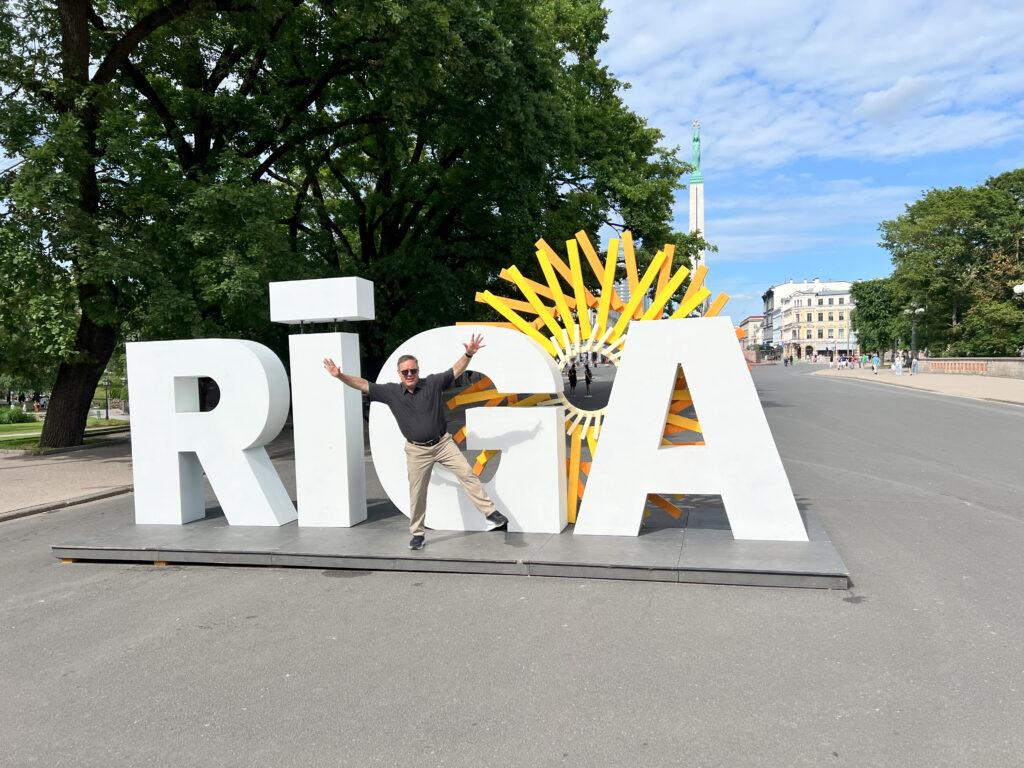
Exploring Riga, we saw layers of this history. Coming from Helsinki, a modern city with a carefully preserved history, Riga felt like a blend of both worlds. The old squares, churches, and architecture brought centuries of history to life, going back to the 1300s and 1400s, well before America was founded. There is also a blend of newer architecture inserted through the town. Also, not many people know that the first Christmas tree was decorated in Riga.

The highlight and main reason for my trip was to experience Midsummer. I joined locals in their traditional festivities. Latvia has very old cultural roots, with traditions that celebrate nature, centered around the sun as a source of energy and life, especially for crops. Given its northern latitude—similar to Fairbanks, Alaska—Latvia experiences long, dark winters. So, the summer solstice, the longest day of sunlight each year, is a time of major celebration. People come together for dancing, singing, and wearing traditional dress. Men wear oak wreaths and women wear flower wreaths on their heads. I donned an oak leaf headpiece, sang traditional folk songs and danced around the bonfires. This experience was surreal—here I was, celebrating the Midsummer solstice as my ancestors had, feeling a profound connection to my roots. At the end of the night, we threw our oak leaf wreaths into the bonfire as is customary.
The tradition is to light the bonfire and stay up all night to make the most of this special day. Did I stay up all night? Almost! We stayed out late, but I had a flight early the next day, so I didn’t sleep much, just to make sure I didn’t miss my flight!
Also, I lost weight leading up to this trip, and a big part of it was shifting my mindset. I started to see this journey as an opportunity to improve my health and fitness on multiple levels. It made me realize that I need to focus on my own well-being and take better care of myself. I gained a new perspective—walking everywhere is just a natural part of daily life in Europe, and it made me appreciate the benefits of staying active.
This Baltic adventure wasn’t just a journey through historic architecture or beautiful landscapes; it was a lesson in how heritage, meaningful places, and traditions shape humanity, well-being, and create connections. It was my glimpse into a deeply communal culture that prioritizes shared experiences, staying active, and finding joy, qualities I think are overlooked in today's fast-paced world.

At HBG Design, we see travel as a powerful source of inspiration, broadening our perspectives and enriching our work. This month, we honor the impact of global exploration on our designs—a legacy rooted by our co-founder, Gregory O. Hnedak, FAIA, whose passion for experiential learning lives on in HBG’s GOH Travel Scholarship. Greg believed that immersing oneself in diverse cultures opens doors to deeper, more meaningful design. His challenge to us remains:

Recognizing Emily Marshall as a "Women Who Lead Design" Honoree
Read the full article in the Memphis Business Journal

The Memphis Business Journal recognizes Emily Marshall HBG Design Interior Design Leader as a "Women Who Lead Design" Honoree.
Emily Marshall is proudly decisive about her biggest career achievement. It “undoubtedly lies in the growth and development of HBG Design’s interior design group.” Over her 14 years with the firm, she helped grow the team from four to 21 pros, calling it a rewarding endeavor. She says that’s given HBG a “unique edge in our integrated resort, entertainment, and hospitality market sectors.”
She adds that what also sets HBG apart is the teams’ collaborative approach of its architects and interior designers working hand-in-hand from the inception of projects.
Emily is focused on a few big professional goals, one of which is expanding the interior design team within its national offices, especially Dallas. Soon, she’ll work on designing a new Marriott hotel at the 100 North Main development. And she’s “profoundly invested in the holistic development” of team members — seeing their successes gives Emily pride and joy.
On trends: “One of the most exciting trends I’m seeing in our industry is the emergence of experiential and immersive food and beverage/restaurant designs. These spaces are meticulously crafted with attention to detail, where every design selection is thoughtfully curated and resonates purposefully with intention. What I find particularly captivating are the rooftop patio restaurants, uniquely designed to blur the lines between indoor and outdoor spaces. These spaces offer a harmonious environment that engages all the senses, creating unforgettable experiences for guests.”
Other articles featuring Emily:
https://hbg.design/hbgs-pick-of-the-trends/
https://hbg.design/hbg-dives-into-the-trend-pools-and-spas-at-casino-hotels/
https://hbg.design/hbg-designers-share-post-covid-design-solutions/
Urban Hotel Design: Embracing the Complication
by Thor Harland, Senior Architectural Designer, HBG Design
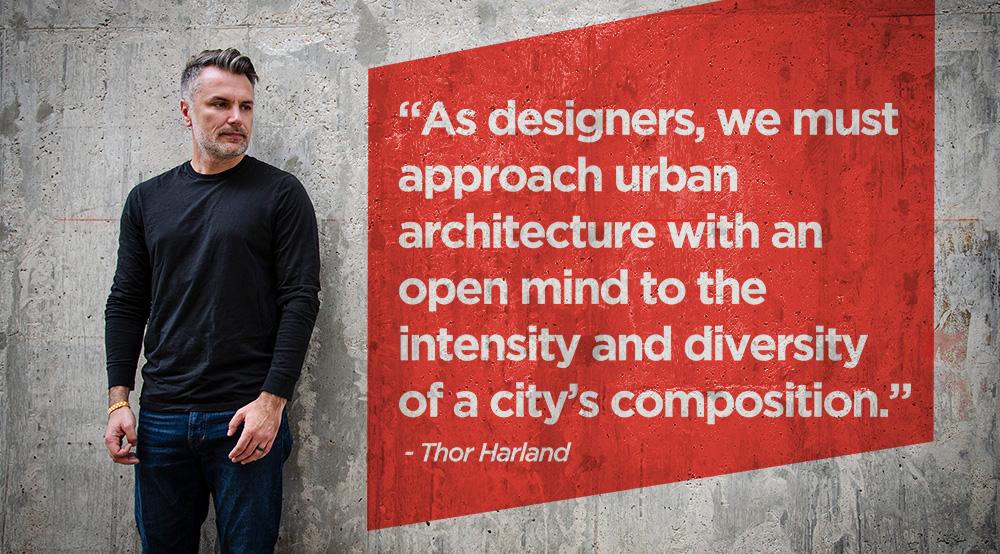
For me, the excitement of urban architecture originates from its inherent complications. It is the limitations and layers of thought that we as designers must critically analyze before introducing new concepts into an already dense city environment.
In most urban settings, available sites for new construction are tightly positioned between existing structures. Each building serves a different user function yet remains connected to the whole. Aesthetics and materiality often vary significantly from building to building, irregular and sometimes raw depending on the age. Some sites retain elements of structures long unused.
New project designs created within the urban framework should be informed by these and other constraints. Historical precedents and environmental context supply ample opportunity to evolve the city’s character.
Our design teams approach these projects with an open mind to the intensity and diversity of a city’s composition. The solutions to these challenges inform the shape, materiality, and function of all new building designs. After all, the more problems a building solves the more value it brings to its surroundings.
In downtown Memphis, Tennessee, three recent hotels designed by HBG Design serve as diverse examples of how a new, evolved design character can reinvigorate the urban landscape bringing immense value to the city collective.
The Canopy by Hilton Downtown Memphis, the Hyatt Centric, and the Caption by Hyatt Beale Street Memphis hotels all represent projects that required thoughtful and rigorous design study to reach their ultimate solutions. Lying vacant for 12 years, the site of a former 50’s era hotel, and a riverside lot with an adjacent 19th century machine shop were each initially viewed as being of limited interest to prospective tenants; some even considered them to be urban blight. Through a new lens, the Canopy, Centric and Caption hotels unveiled opportunities for designers to bring out each building’s individual characteristics and iconic identifiers, ultimately creating enormous community impact.
Canopy by Hilton Downtown Memphis Hotel – Renewing a Gateway Site into Downtown Memphis
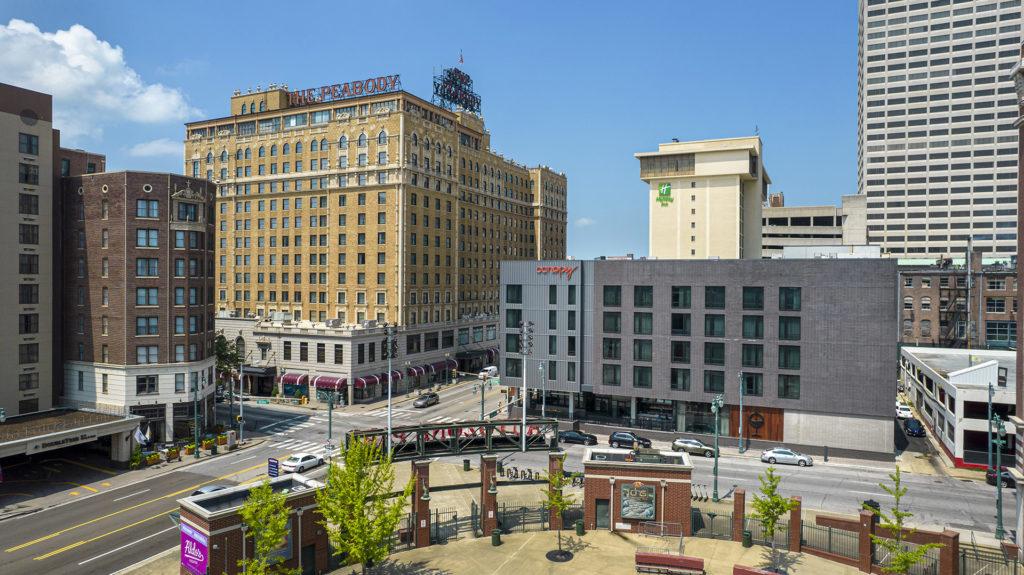
Located at an important gateway into downtown Memphis’ urban center and its historic, world-famous attractions, the Canopy hotel replaced the dilapidated Benchmark Hotel, that was still occupying the site. This corner of Union Ave. and BB King Blvd. is the iconic location of the Peabody Hotel and AutoZone Park, only a few shorts blocks from Beale Street.
The Canopy design and construction was extremely complex to navigate, given the owner’s desire to keep existing building structures and foundations from its previous hotel incarnations. The conflicting structural challenges were ultimately transformed into useful square footage and its solution informed a simplified hotel geometry and a comprehensive expression that created a unique dichotomy between upper and lower floor masses.
The project consists of a 171,100 square foot hotel block elevated above a visually transparent podium level and one level of subterranean parking. The hotel block maximizes the site’s guestroom potential through a double-loaded guestroom corridor ring surrounding an internal light well. A sense of transparency and natural daylighting in the hotel’s base level is achieved through floor to ceiling storefront systems along the South and East edges and two large skylights located under the light well that amplify the restaurant, lounge, and bar amenities.
A Discerningly Rebellious Urban Design, of its Time and Place
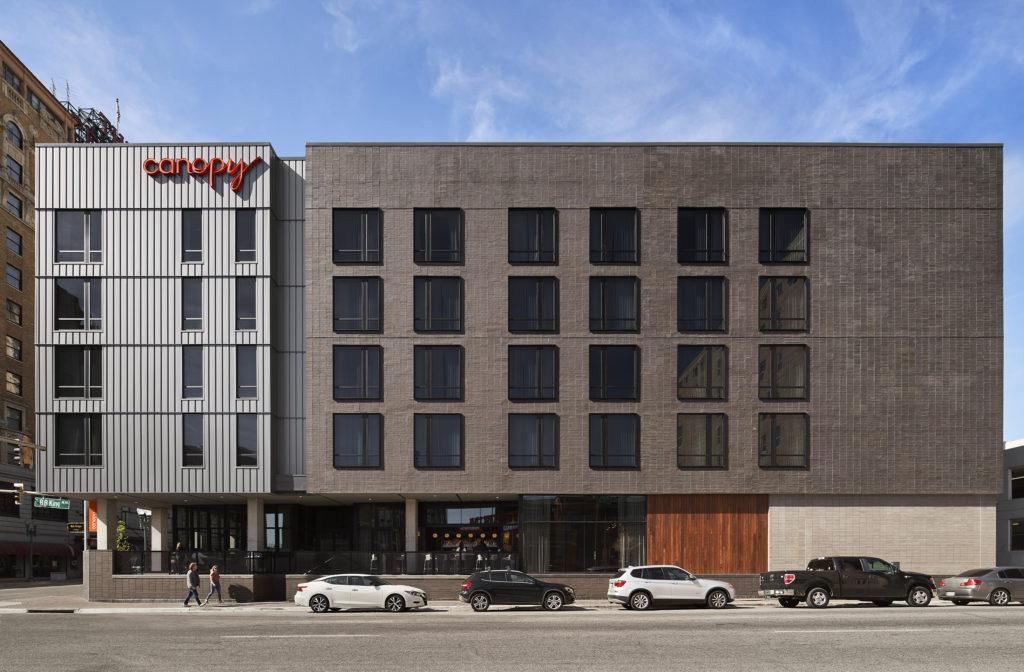
To me, great architecture evokes unexpected beauty and resistance but is based in unarguable logic. Through our project visioning, brand interpretation and concepts, the Canopy architecture became less about individual expression and more about amplifying the neighborhood experience in Memphis as the city is today.
The Canopy hotel structure is meant to be a building of its time, and an evolution of Memphis’ downtown personality. We considered the historical precedents and the progressive concept of the Canopy brand; and we used these themes as idea generators for our explorations. The result is a concept that is respectful to place, but also a representation of its contemporary generation.
Downtown Memphis architecture has a long industrial history with rows of ornate brick hotel, office and former warehouse buildings lining the urban streets. The materials, proportion, scale and well composed fenestrations of the Canopy are meant to evoke the characteristics of the existing network of mid-rise masonry architecture in the downtown area.
Brick was an important material for continuity, but the size of the brick is slightly different at the Canopy. We used a larger scale brick, and the patterning isn’t a typical running bond; it’s a stacked bond pattern. So, there is some deviation there that helps give the building its own identity. It’s the slight, subtle differences like that and just the overall geometry of the heavy upper floor mass floating above the open public space below that helps to differentiate the design from its neighbors.
A dark charcoal gray palette and simplification of form contemporizes the visual aesthetic of the architecture. It’s discerningly rebellious. I love that an Avant Garde result can be created through rigorous historic, aesthetic, and structural investigation and a direct reaction to the project’s context and objectives.
In the Canopy design, we have produced a unique complement to neighboring buildings, and also a structural acknowledgement of Memphis’ continued evolution as a city with its own intricate personality.
See more Canopy Hotel photos here.
This is part one of two in Thor Harland’s series,
Urban Hotel Design: Embracing the Complication
In part two, Thor and other designers will discuss how Memphis’ One Beale Mixed-Use Development gave rise to a full historic city block of branded hospitality, including the Hyatt Centric, and the Caption by Hyatt Beale Street Memphis hotels.
Spotlight on HBG's Emerging Professionals Studio
A discussion with HBG Design’s Emerging Professional Studio (EPS) Leader and recently licensed architect, Ryan Callahan, AIA
Ryan, as the new leader of HBG’s Emerging Professionals Studio (EPS), can you give us some background on the program?
While my involvement in the Emerging Professionals Studio began five years ago, HBG Design’s EPS program was conceived about 15 years ago as a group led "by EPs for EPs", providing opportunities for leadership experience within the firm at an early career stage.
The EPS originally focused on helping emerging architecture professionals through the AXP architecture licensure process and also provided opportunities for team building. The program has evolved to serve expanded EP career needs, including welcoming HBG’s interior designers into NCIDQ licensure study while also focusing on individual leadership development.
As a practice that integrates architecture and interior design to create hospitality design experiences, it was imperative that the EP Studio evolve to support the way our firm works and collaborates. Architects and interior designers have different licensure requirements and different ways we approach a project based on the nature of our disciplines, but we share similar goals and many commonalities, which are incorporated in the EPS program.
Our EPS today is rooted in the idea that emerging professionals desire structure in working towards licensure, but also want the flexibility to easily modify the pace of their journey as their personal or professional life changes. Mentors play a key role in helping EPs find their path individually and as a group, actively developing support strategies and needed resources for licensure in ways that matter most to each individual in their particular stage of development.
How did you become a leader of EPS?
I had just passed my remaining Architectural Registration Exams (AREs) a few months before Nathan [Peak, HBG’s Practice Leader] asked me to lead the EPS group. I think he asked me specifically because I was newly licensed, but also because I was part of HBG’s pre-Covid EPS program culture. As our workplace returned to the office, we all wanted to find ways to reengage our EPs into a group-learning mindset and provide the kind of supportive group environment that we had before the pandemic, and had been missing for over two+ years. Covid was so disruptive to everything, to the way we do things, even to my own growth. I entered and came out of Covid in a different phase of life. A lot of things changed. For example, I was just newly married entering Covid. When we went into work-from-home mode during this weird, sort of hyperbolic isolation, I came back to the office as the father of two boys. Now, I’m more aware of the level of involvement that people in different stages of life can have after work hours, but I’m also more focused.
And, of course, I could not lead EPS without others. In our Memphis office, Chris Wood is co-leading on the interior design side. And in our San Diego office, architect Nathan Blair and interior designer Alexandra Milkovich are leading the local EPS activities.
How has the EPS changed since you started?
For the first two years of my involvement in EPS, we had about 20-30 EPS members. It seemed like our EPS culture revolved around in-person knowledge exchange forums, recreational sports, and group learning activities. Of course, the pandemic changed everything, and put a damper on group events. We are now recapturing that level of camaraderie and have a great EPS group and supportive firm culture. I am seeing our group involvement increase every month.
The “work-from-home era” did teach us how to become more technologically resourceful and interconnected across distances. With more variety of tools enabling us to work virtually, we were able to put study information at each EP’s fingertips. All HBG’s EPS study information was organized, cataloged by topic, and made accessible through our MS Teams cloud-sharing platform. I’m proud to say we didn’t let the pandemic become a huge obstacle to getting our EPs help. For me, the biggest hurdle was just getting started.
What’s new for the EPS at HBG Design?
Knocking out AXP experience hours quickly is everyone’s goal when they get out of school, because there are a lot of hours required! EPS continues to coordinate supplemental training, quarterly site visits/project tours, exam study sessions, and professional engagement with design industry organizations. And our project staffing tracks EPs who are actively pursuing licensure to connect them with needed AXP hours.
EPS leadership has also been developing onboarding courses to help new hires become fully engrained and fluent in HBG’s design processes. This is the information they didn’t and couldn’t learn in school.
This is a bit like HBG’s version of the NCARB AXP program re-formatted into a series of lessons from seasoned professionals at the firm who each offer over 20 years of industry experience. These seasoned professionals lead regular meetings to share topics on the firm’s building processes ranging from codes to life-safety; space planning to hospitality design to sustainability to construction detailing - all supporting knowledge sharing and the path to licensure through ARE, NCIDQ and LEED testing.
“Knowledge of how something is constructed is very valuable. It doesn’t matter if you are selecting a finish or drawing a wall or designing a building. If you know how it goes together, it goes together better,” says Ryan.
How are EPS participants given a voice?
Everyone in the EPS group is empowered to initiate a discussion, lead an event or portions of a group project, or given freedom to implement a new process they feel passionate about and that will lead to growth of their peers and colleagues.
Weekly ‘Coffee + Collaboration’ mornings offer an all-employee open platform to initiate design discussions based on active project reviews to help inform the general direction of design or seek input on how current projects could be improved. EPs and student interns work together as valued project team members, gaining exposure to design challenges as well as opportunities to exchange ideas. They get a lot of encouragement to add their input in project design critiques in an environment where every voice is respected. This adds to EP’s experience in acquiring increasing levels of hands-on design leadership and really finding their voice.
We also have a number of international AIA members and EPS gives them a road map to licensure in the U.S. after becoming licensed in another country. The EPS is really benefiting from the variety of viewpoints and experiences of our EPS members. They each bring different approaches and well-rounded perspectives to the group.
Is EPS all business?
Career fulfillment is heavily dependent on engagement with co-workers. Now that we are MOSTLY out from under the pandemic, I think it’s important for the EPS to continue promoting relationship building and providing bonding opportunities among co-workers and within the EPS. These group experiences build an authentic sense of camaraderie that builds trust and makes the work experience much more inspiring and positive.
From painting parties to kick-ball and indoor soccer teams; group nights and happy hours at new restaurants to family-centered outings, EPS is actively improving our post-Covid in-person firm culture and making the firm a stronger, more dynamic organization.
Creating Depth, Meaning and Authenticity in the Gaming Experience
"Casino design is its own special artform that has long since evolved from being simply a structural box with slot machines inside. At the best casinos and resorts, the casino designs are exciting and lively, but are also inspired by meaning and authenticity, with a beautiful flow from one amenity to the next.” - Christopher Wood, NCIDQ, IIDA, HBG Design
Christopher Wood, NCIDQ, IIDA, Lead Interior Designer and a casino design specialist contributes to this month's 'HBG Design Thinking'. Chris discusses how inspired, authentic and meaningful design can help differentiate and enhance the guest's gaming experience.
First, Chris, why are you passionate about casino and entertainment design?
Chris: As a casino design specialist here at HBG Design, I love creating spaces of refined elegance with a bit of glitz and glam. I love finding subtle ways to elevate a space. And it helps that I have a penchant for all things that sparkle. That tends to work well in casino design. The casino is the nucleus of the guest experience for a casino resort. Bringing in intricate detailing and refinement through materials that truly shine is something that always gets my creative juices going.
As a casino designer, where do you and your team find your design inspiration?
Chris: At HBG, we are fortunate to work with many distinctive tribal and commercial gaming clients with strong cultures, brands and regional ties, in some cases, to native ancestral lands. I love learning about our clients’ cultures. Being able to highlight stories of heritage respectfully, creatively, and typically within a more contemporary casino design framework, is challenging yet exciting.

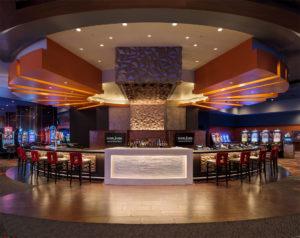
Shown above: the design of Ho-Chunk Gaming, Black River Falls, Wisconsin was directly influenced by the light and shadow filtering through the northern Wisconsin woods.
Nature is also a tremendous aspect of regional design inspiration. There is so much beauty in the world. Finding new ways to bring the outside world into our designed spaces is an unexpected surprise, especially in a casino. I like to reference underlying elements that we don't often think would be associated with a casino. For example, a sunrise, light and shadow, the night sky.
Each story can form the basis of a string of conceptual ideas that are personal and unique to each Owner. One-of-a-kind design really complements and elevates a gaming experience. We use ambience and emotional response to separate a property from the [casino] pack.
Can you give an example of a design inspired by culture or nature for regional customers?
Chris: Yes, the Tule River Tribe in California is currently developing their new 105,000 square foot Eagle Mountain Casino in Porterville, CA, which will enhance the tribe’s gaming and F&B amenities with a fresh interpretation of Tule River Tribal culture and heritage. Our design team merged cultural storytelling concepts with amenities and distinctive venues designed specifically for the Porterville gaming customer.
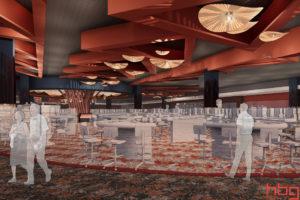 Key design concepts are rooted in the land and agrarian context of Tulare County and Central California with the design influenced heavily by a lodge aesthetic with wood and stone structural expressions. Inside, guests will experience an abstract depiction of the Tule River Tribe’s native traditions through art, patterns, and imagery. Soaring vertical features recall the majesty of the Giant Sequoia and the Golden Eagle, each important representations of tribal culture. Flowing forms will recall the winding Tule River and organic curves of nature.
Key design concepts are rooted in the land and agrarian context of Tulare County and Central California with the design influenced heavily by a lodge aesthetic with wood and stone structural expressions. Inside, guests will experience an abstract depiction of the Tule River Tribe’s native traditions through art, patterns, and imagery. Soaring vertical features recall the majesty of the Giant Sequoia and the Golden Eagle, each important representations of tribal culture. Flowing forms will recall the winding Tule River and organic curves of nature.
Custom terrazzo medallions of tribal basketry patterns will enhance the entrance concourse. Display cases will feature tribal artwork. The casino ceiling design features the Tule River Tribe's Flight of the Butterfly and Quail Tufts cultural pattern. Chandelier designs are inspired by native basketry. The carpeting is evocative of a shadowed forest floor. Wood accented columns help bring alive the idea of the towering sequoia.
Is there a particular aspect of the Eagle Mountain Casino project that you think will stand out to guests?
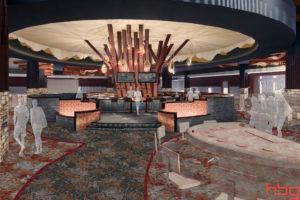 Chris: The Eagle Mountain Casino’s ceiling design and center bar is a design that I am particularly proud of for its eye-catching aesthetic. Guests will witness a culturally significant center bar design that harkens to the concept of fire as a community gathering place. We designed in elements reminiscent of glowing embers of a dwindling fire, and sourced custom floating ember-look light fixtures. A focal back bar element recalls stacked firewood. Warm crimsons and deep navy blues help express the color range that fire can have, leaving those gathered feeling warm and social.
Chris: The Eagle Mountain Casino’s ceiling design and center bar is a design that I am particularly proud of for its eye-catching aesthetic. Guests will witness a culturally significant center bar design that harkens to the concept of fire as a community gathering place. We designed in elements reminiscent of glowing embers of a dwindling fire, and sourced custom floating ember-look light fixtures. A focal back bar element recalls stacked firewood. Warm crimsons and deep navy blues help express the color range that fire can have, leaving those gathered feeling warm and social.
Are most Owners receptive to integrating cultural elements into the casino design?
Chris: Our team’s experiences working with Tribal design, especially, have been very diverse. We have created literal interpretations and incorporations of cultural identity into the entertainment experience. And have also designed more contemporary, abstracted nods to culture and heritage.
We design to each Owner’s specific vision; so no designs look alike. And, because many of the tribal casinos are often legacy investments supporting tribal communities, the casino design treatments can be incredible opportunities to create personality, emotion and memory within the context of a meaningful destination experience.
HBG's Five Trends for Transforming Hospitality Design in 2022
The pandemic has redefined hospitality design, but the reason why guests come together to share experiences hasn’t changed. It's more critical than ever to apply thoughtful, flexible and wellness-focused design sensibilities to hotel spaces, guestrooms and amenities. HBG Design Leaders Nathan Peak, AIA, LEED GA, Practice Leader, and Emily Marshall, IIDA, NCIDQ, Interior Design Director, present five trend ideas for transforming hospitality design into 2022.
Multi-Functionality and Spatial Flexibility
Greater work flexibility has resulted in an increase of blended leisure and work travelers. We see a fresh reframing of hotel “zones” into residential-like multifunctional “work / dine / gather” spaces that easily align with evolving travel needs.
“The lines between work, travel, living and leisure are now blurred, which is a clear outcome of the pandemic.” - Emily Marshall
Many of HBG Design’s hotel and resort clients have re-prioritized their amenity offerings to provide an optimum alternative work environment for the “blended traveler”. To accommodate the blurring lines between work, travel, living and leisure, hotel lobby and public spaces are being designed in zones that easily shift from quiet virtual workspaces with auditory privacy to collaboration hubs for business interaction, to social areas depending on the needs of operators and their guests. The wide-open space idea is the foundational element, giving hotel operators the ability to blur the purpose of the space itself, based on the needs and wants of their guests. In fact, the in-room, remote work experience has – in many cases – become as important as delivering exceptional, traditional resort amenities, and that trend shows no immediate slow-down.
At Hyatt Centric Beale Street Memphis and Canopy by Hilton Memphis, both designed by HBG Design, we created residential inspired co-working zones with the idea of adaptable, flexible and technologically connected public spaces.
Experiential Design for Aspirational Travelers
Travelers are “breaking free” after months of pandemic isolation in some cases. Aspirational travelers are in search of memorable experiences and shareable moments inspired by art, architecture, design, history, and unique locales.
Hotels must offer new and creative experiences for guests in order to compete with the myriad of accommodation options in the marketplace, such as VRBO and SONDER. Local and regional materials, local artisans and custom design will all play a vital role in expressing authenticity in unique and artful ways, as designers seek to achieve an aesthetic that is “of the area” and create experiential moments.
At the Hyatt Centric Beale Street Memphis, HBG designers created a strong sense of place and a distinct ‘localvore’ Centric brand experience by drawing conceptual inspiration from Memphis’ rich music and riverfront industrial history. The contemporary hotel's staggered patterning of the window placement recalls sheet music and guitar fret patterns accentuated at night with bars of light to provide a musically inspired programmable light show. The Beck and Call rooftop whiskey bar features several selfie-worthy design opportunities like a colorful rooftop mural, the best river view in the city, and portraits of famed musicians with Memphis ties, including Tina Turner, Justin Timberlake, Isaac Hayes, Valerie June, and Yo Gotti.
Restoration Through Nature
To enhance mental well-being, guests will seek out serene environments that offer respite and natural context that blurs the lines between indoors and outdoors. We anticipate an elevated demand for wellness-related amenities.
“The pandemic highlighted our need, as humans, to interact with nature.” - Nathan Peak
Humanity is hard-wired to seek physical and emotional connection with nature to feel healthier and more energized. It’s about creating a relationship between the interior and exterior that enhances guest responses to environmental stimuli and creates sensory experiences. Biophilic design methods underscore how a guest feels in a given space, which contributes significantly to experiential design. Bringing the outdoors inside through light, open design and integration of natural elements creates a feeling of restoration, wellbeing and happiness where guests respond positively --- a result every property seeks to achieve.
The architecture and shaping of the Hyatt Centric Beale Street Memphis lobby space creates beautifully framed views of the Mississippi River while dappling the public spaces with ample sunlight and reflections from the constant movement of the mighty river beyond. Outdoor Riverview dining and a landscaped pool and event courtyard “oasis”, complete with green lawn and a green wall, create a distinctive respite in the downtown core.
Guestroom Technology
Automatic technology will continue to advance the curated and customized guestroom experience offering options for convenience and comfort.
There are times when the greatest luxury in travel is knowing you’ll have no surprises upon arrival. Everything you want, exactly how you want it can be ordered and confirmed for your stay, before you ever walk through the hotel entrance. Not only can you check-in to your hotel room virtually, but you can select your room size, floor, view, accessibility to amenities, upgrades, etc. Access to no-contact services and experiences aren’t reserved for check-in; literally everything a guest wants or needs can be delivered directly to the guest room, and often by simply using voice commands from the comfort of your room. From voice-activated concierge services to voice or motion control of lighting, audio-visual systems, and room temperature, automation is proving to elevate convenience for the guest and permeating all aspects of the hotel experience.
"Within the room, I am especially fond of the motion detecting floor lighting technology designed into the beds in our Hyatt Centric Beale Street project. Gone are the trappings of navigating an unfamiliar room in the middle of the night; the integrated technology in our bed design creates a soft glow of light in the room as soon as your foot hits the ground." - Emily Marshall
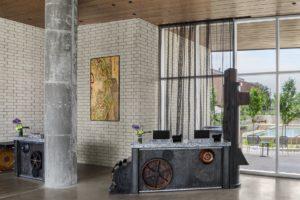
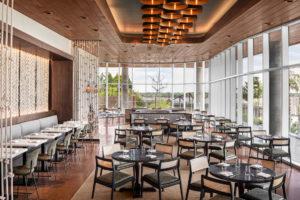
Regional and Early Material Sourcing
Material shortages, higher costs and longer-lead times are straining hotel project schedules. Regionally sourced materials will help overcome supply chain demand challenges. Procurement in the early design phases will help ensure construction availability.
“Carefully sourced regional options can not only circumvent such transportation and tariff issues, but they can also promote greater connection to place in meaningful ways.” - Emily Marshall
Many of these issues the industry is experiencing can be navigated during the early design phases with the right guidance from a knowledgeable team who understands the inner workings of available products and materials. Interestingly, we are seeing a stronger focus on the specification of domestic made products, which is good for the economy at large. The engagement of an experienced designer, construction company, FF&E procurement agents, and vendors early in the design process is critical, as products and materials quantities require early confirmation and additional lead time in ordering.
One way HBG Design is working around the supply chain situation is by using more regional manufacturers who employ skilled tradesmen who build case goods and millwork in a shop, versus working onsite. This not only keeps the level of quality high, but also increases efficiency of labor.
"HBG Design is looking at everything from design to delivery through a different lens heading into 2022, while reimagining the way spaces are used, designed, and furnished. And that, in the long run, will be better for everyone." - Nathan Peak
Caption by Hyatt Memphis on Top Hotel News 2022 Hotlist
2022 Hotlist: HBG Design's Caption by Hyatt Memphis Named One of Hyatt Hotels Corporation’s top three openings
The Unbound Collection, Caption by Hyatt and Hyatt Centric are all eagerly awaiting the arrival of eye-catching schemes next year, each of which draw on their surroundings for inspiration.
Caption by Hyatt Memphis
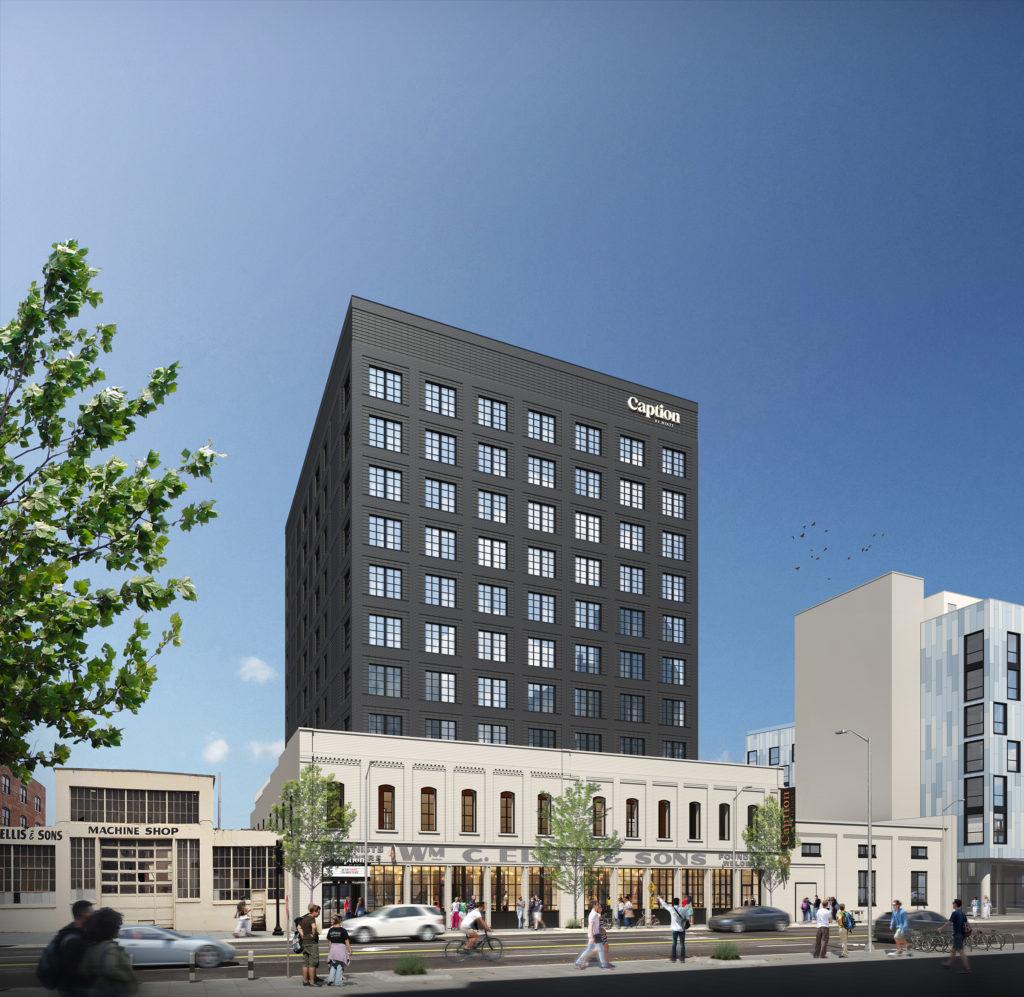
Currently under construction and expected to open in the second quarter of 2022, this new Caption by Hyatt hotel in Tennessee will encourage guests to embrace self-expression in a space focusing on experience and connection.
Hyatt is creating this 140-key property, which will be located at One Beale Street and integrated into the historic main building of Wm C Ellis & Sons Ironworks and Machine Shop, in partnership with Carlisle, while HBG Design is the architect and interior designer.
Caption by Hyatt Memphis will be located partly inside this heritage building and partly in a new guestroom tower, providing views of the Mississippi River and the city’s skyline.
Visitors will be encouraged to relax in the hotel’s multifunctional lounge space, Talk Shop, complete with original features, an expansive patio and a double-height beer garden with open firepits.
The Unbound Collection by Hyatt, Fuji Speedway, Japan
Hyatt Hotels Corporation is to provide a luxury hotel experience at Japan’s historic racing circuit, Fuji Speedway, after entering into a management agreement with an affiliate of Toyota Group for a proposed 120-key property.
Scheduled to open in Q3 2022, the under-construction newbuild scheme represents The Unbound Collection’s debut in Japan.
Amenities at The Unbound Collection by Hyatt, Fuji Speedway are to include multiple fine-dining restaurants, bars, a spa and natural onsen, a fitness centre and indoor pool, a banquet room and conference space.
Drawing on its setting, the property will also boast a car museum, showcasing rare vehicles and the racing circuit’s extraordinary history.
Hyatt Centric Kota Kinabalu, Malaysia
The 150-key Hyatt Centric Kota Kinabalu, which is being developed by Hap Seng Consolidated Berhad, will welcome guests to the heart of the city in a location that provides easy access to the commercial district, retail areas and countless restaurants, along with local attractions such as the Jesselton Point pier.
The architectural and interior design for this property is being led by Kengo Kuma & Associates, with inspiration taken from the lush green hills and blue ocean that characterise the area.
Notable amenities here are to include an all-day restaurant and lounge, a rooftop pool and bar, a fitness centre and 1,900 sq ft of meeting space.
Currently under construction, the hotel’s expected to open in the second quarter of 2022.
Learn more about Caption by Hyatt Memphis.

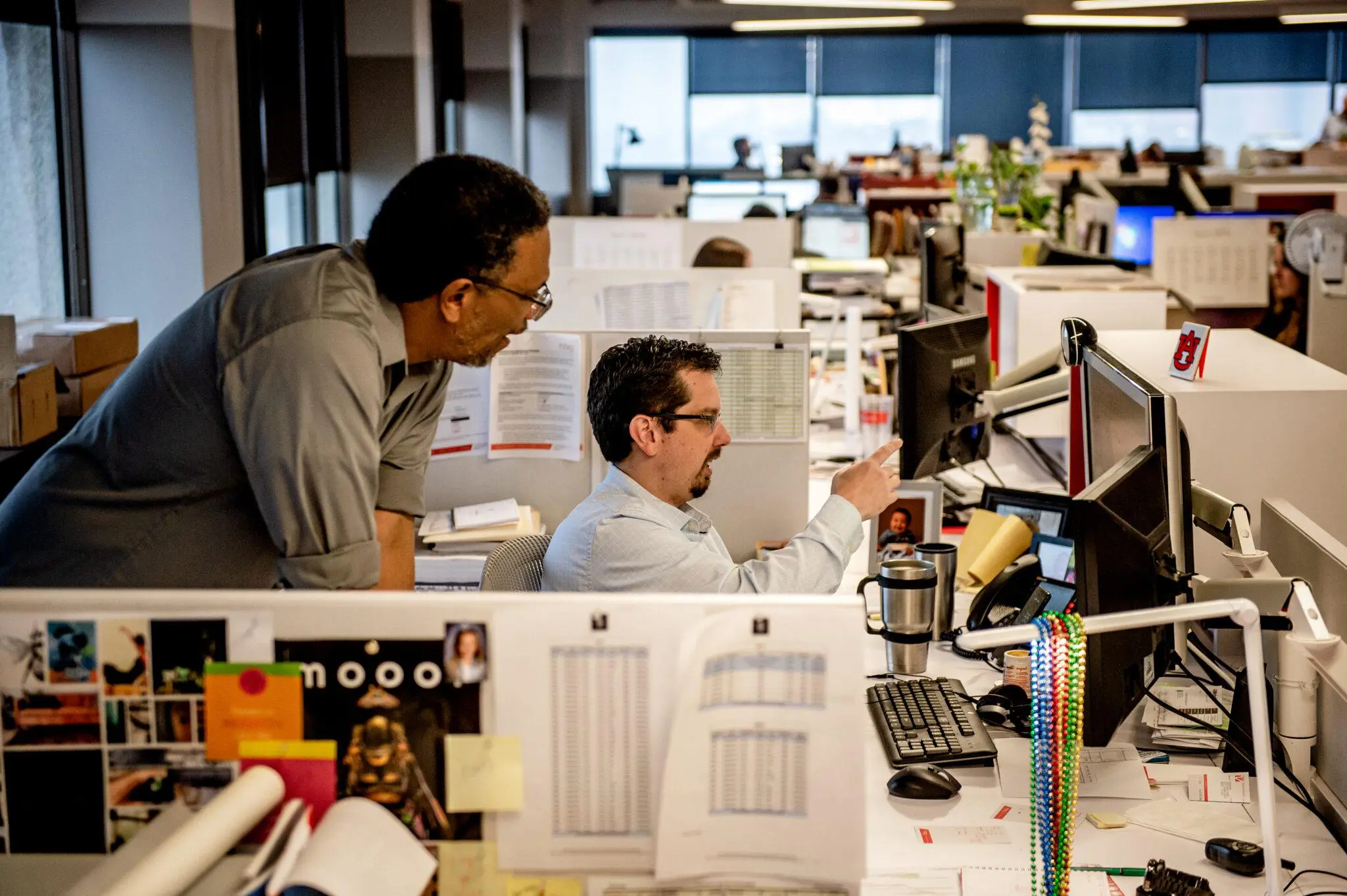

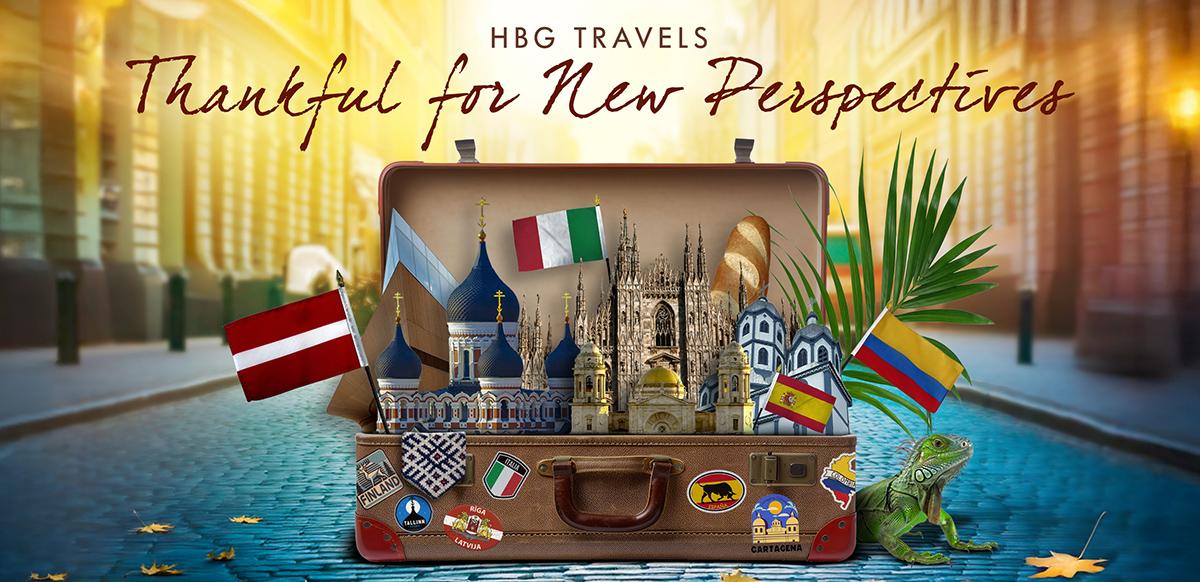



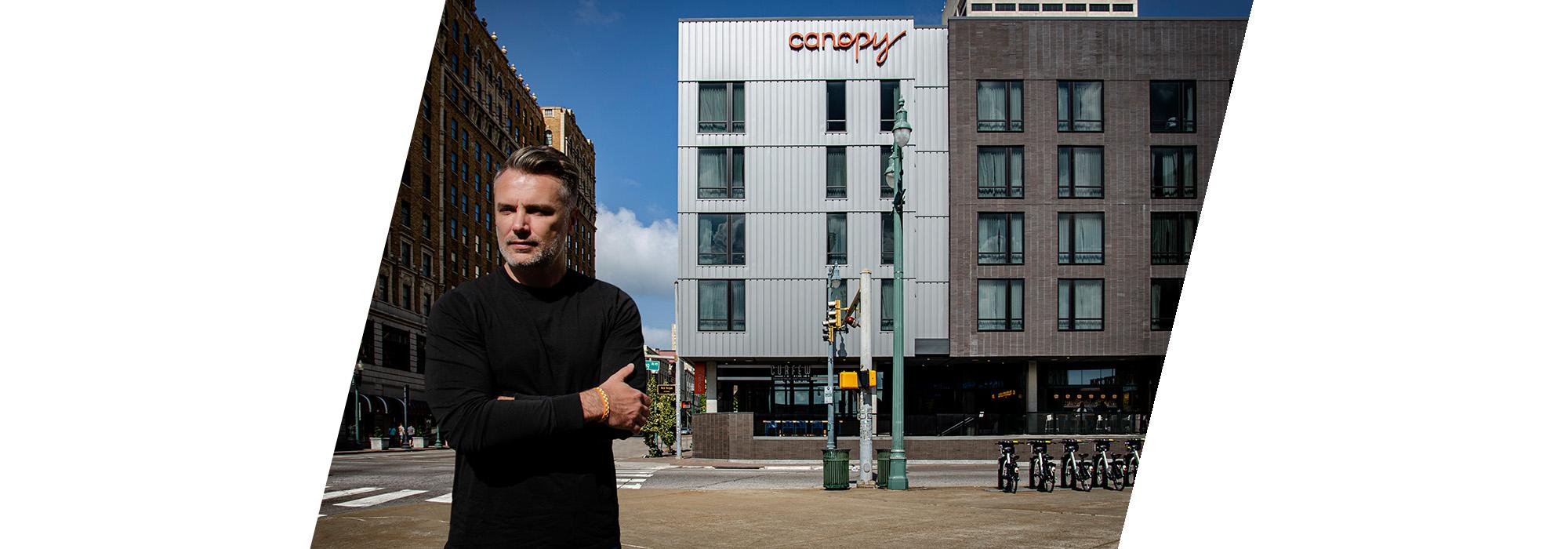
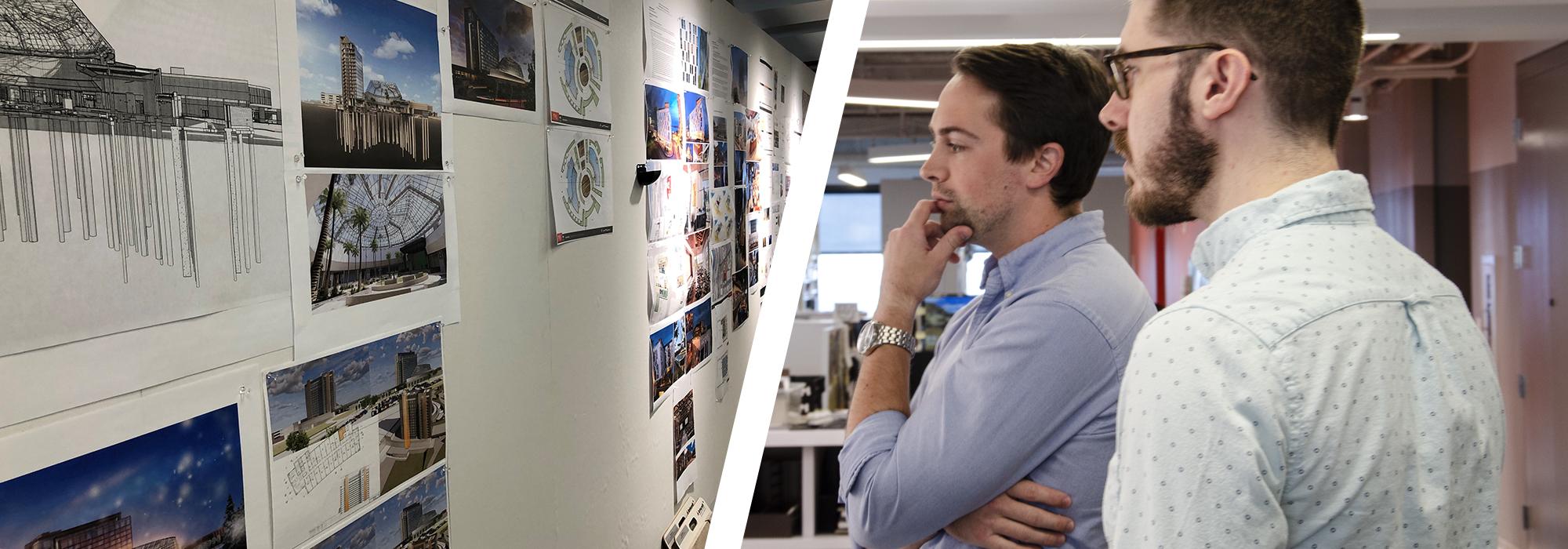

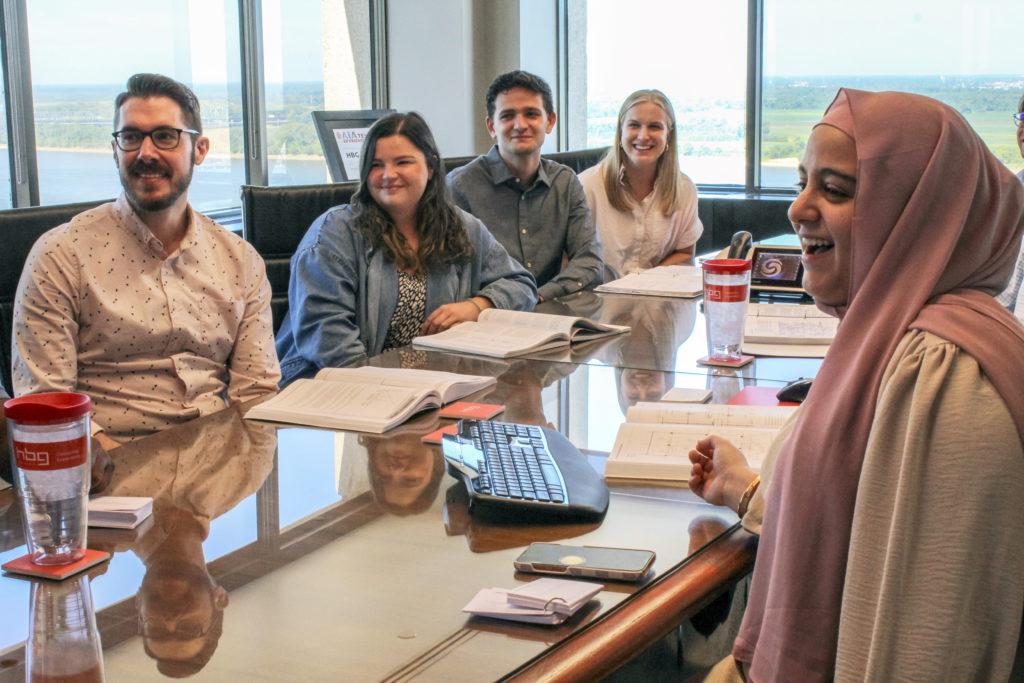
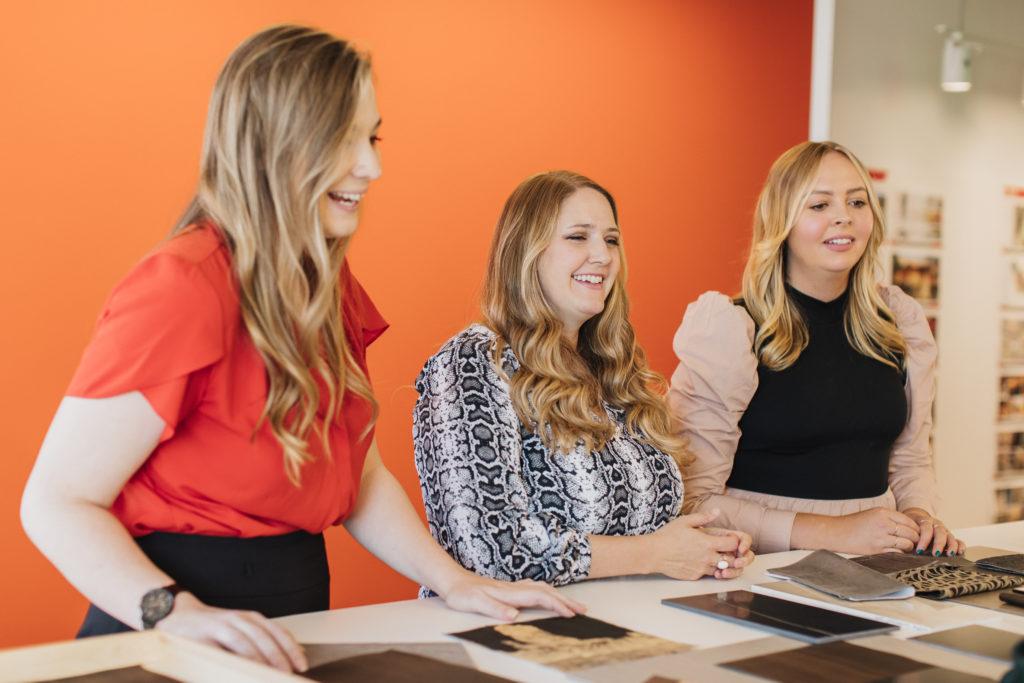 The “work-from-home era” did teach us how to become more technologically resourceful and interconnected across distances. With more variety of tools enabling us to work virtually, we were able to put study information at each EP’s fingertips. All HBG’s EPS study information was organized, cataloged by topic, and made accessible through our MS Teams cloud-sharing platform. I’m proud to say we didn’t let the pandemic become a huge obstacle to getting our EPs help. For me, the biggest hurdle was just getting started.
The “work-from-home era” did teach us how to become more technologically resourceful and interconnected across distances. With more variety of tools enabling us to work virtually, we were able to put study information at each EP’s fingertips. All HBG’s EPS study information was organized, cataloged by topic, and made accessible through our MS Teams cloud-sharing platform. I’m proud to say we didn’t let the pandemic become a huge obstacle to getting our EPs help. For me, the biggest hurdle was just getting started.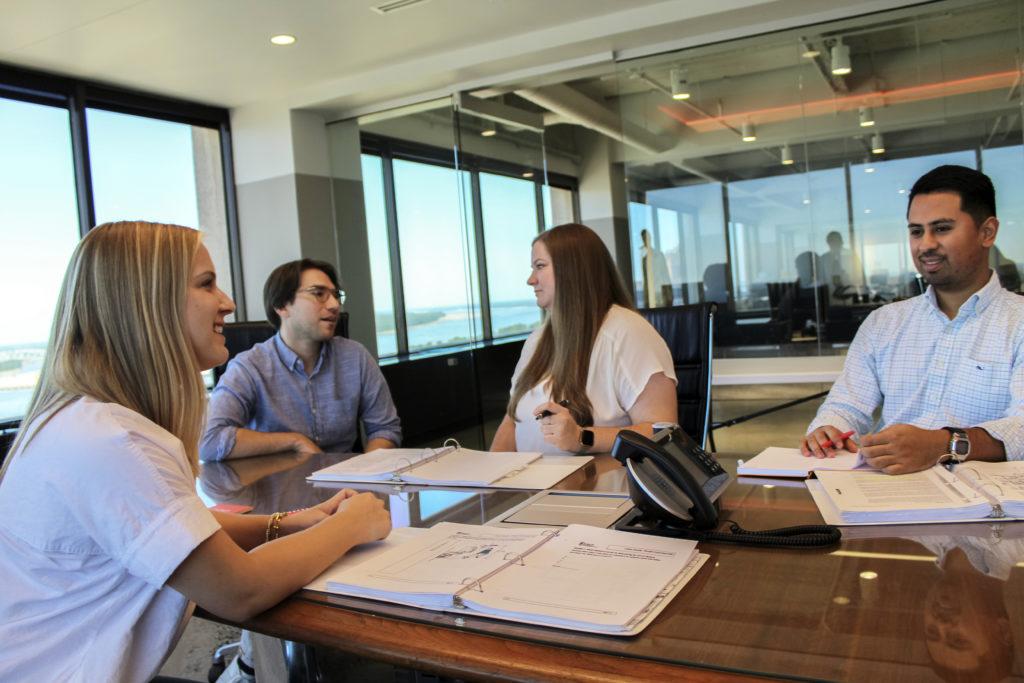 Knocking out AXP experience hours quickly is everyone’s goal when they get out of school, because there are a lot of hours required! EPS continues to coordinate supplemental training, quarterly site visits/project tours, exam study sessions, and professional engagement with design industry organizations. And our project staffing tracks EPs who are actively pursuing licensure to connect them with needed AXP hours.
Knocking out AXP experience hours quickly is everyone’s goal when they get out of school, because there are a lot of hours required! EPS continues to coordinate supplemental training, quarterly site visits/project tours, exam study sessions, and professional engagement with design industry organizations. And our project staffing tracks EPs who are actively pursuing licensure to connect them with needed AXP hours.